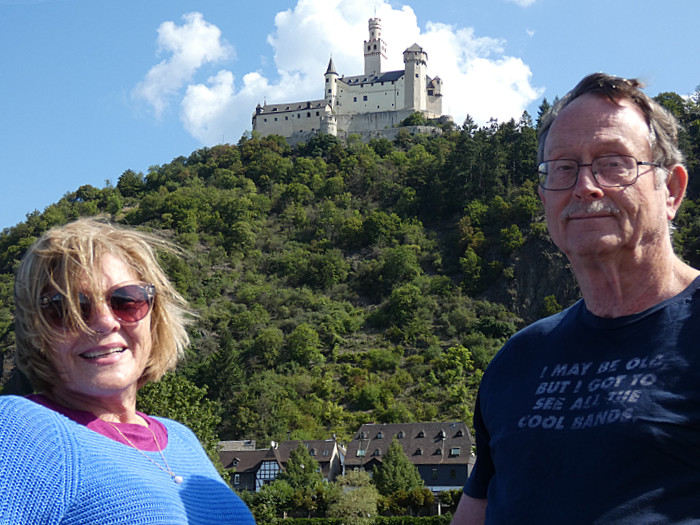Basel, Switzerland
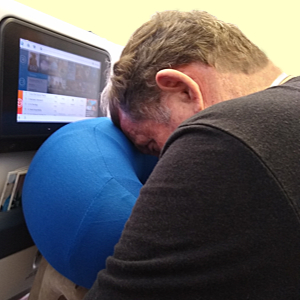
The flight to Basel, through Amsterdam, totaled over 21 hours flying and in airports. We were certainly tired upon arriving at the Swisshotel, but we took Viking’s advice and allowed ourselves only a couple of hours sleep before we started investigating the city - trying to adjust our ‘jet lag’ to the 9 hour time difference with California.
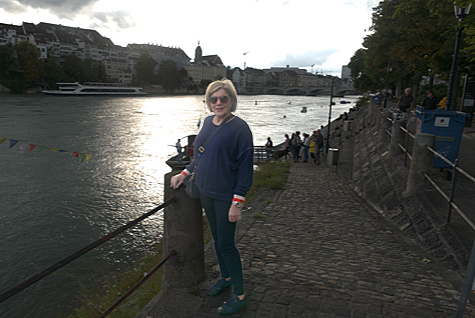
We awoke in the very early evening and headed for the central part of the city - the Marktplatz. Walking down Riehenstrasse to the Rhine River we got our first taste of how different European cities are from those in the U.S. - sidewalks are often just suggested because the streets came long before cars were even thought of and cobblestones are hard to walk on for long with anything but cushioned sneakers.
Here we see Patty just as we first reached the Rhine River.
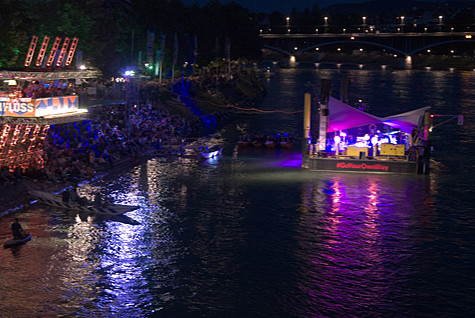
We then turned right, walking along the river to the Mittiere bridge and passed a floating concert hall (Go Your Own Way) setting up to play to people gathered on the shore.
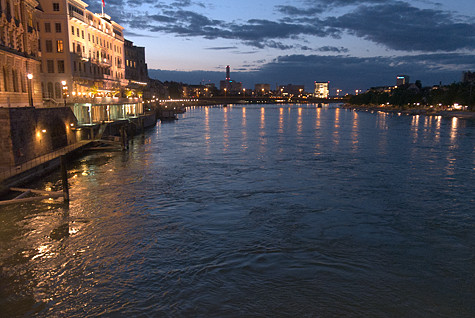
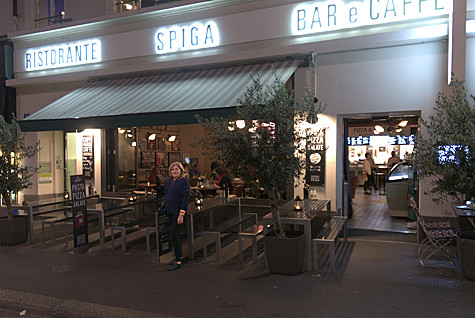
Crossing the bridge, we took this picture of the river on the other side, then stopped at the Spiga Cafe to eat dinner.
Then it was around the corner to Marktplatz - the main meeting square in the city, although there are many smaller squares in Basel. In this one the Town Hall (the dark red building) fronts both the center of the square on one side and the Rhine River on the other. After investigating the square, we walked straight back to our hotel - completing our first day in Europe.
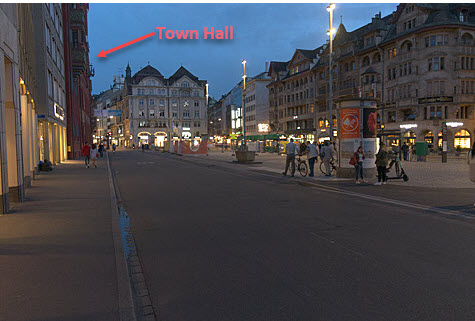
The map below shows the walking path we took Thursday evening in green, 'A' is where the shot of Patty next to the Rhine River was taken, 'B' is the floating concert hall, 'C' is the Spiga Cafe, and 'D' is the Marktplatz shot.
The red lines represent the walking tour we took Friday morning and the blue lines are where we wandered Friday afternoon and evening.
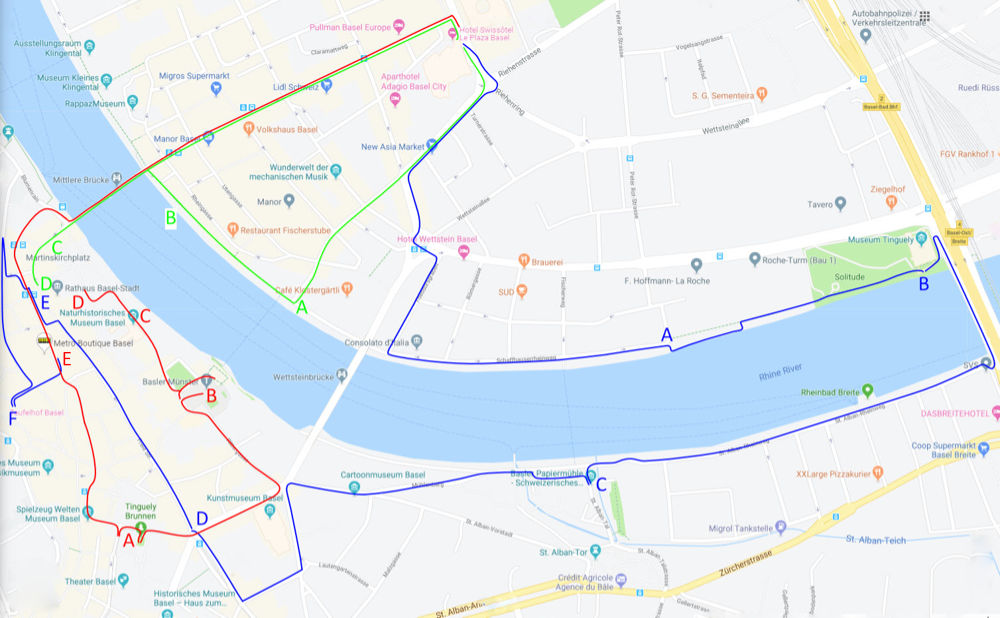
Basel, Day Two - morning
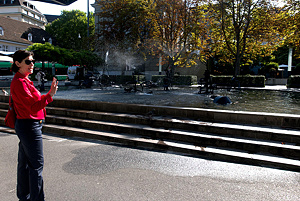
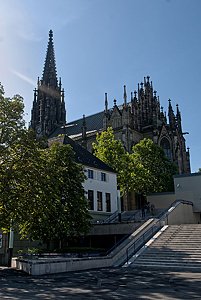
Early Friday morning we took an included walking tour of the city. It started by taking the free city tram system across the Rhine to the Tinguely-Brunnen fountain (A) - famous for all the metal sculpture spouting water in apparent random directions. Overlooking the fountain is Offene Kirche Elisabethen, a neo-gothic church, turned into a museum .
We noticed the large number of very young children traveling by themselves on the free city trams throughout the city. In Switzerland children are expected to become independent and travel by themselves to school and other activities as young as five years old. Of course there are cameras everywhere - becoming much more common in the rest of the worldl - and citizens are also aware of the children.
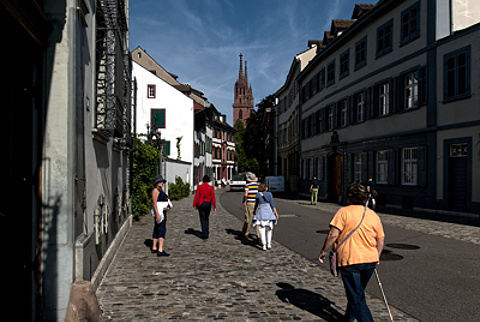
Our walk took us by the Kunstmuseum - the largest in Basel - up the Rittergasse to the Munsterplatz, outside Basler Munster Church (B) - built between 1019-1500 in Romanesque and Gothic styles.
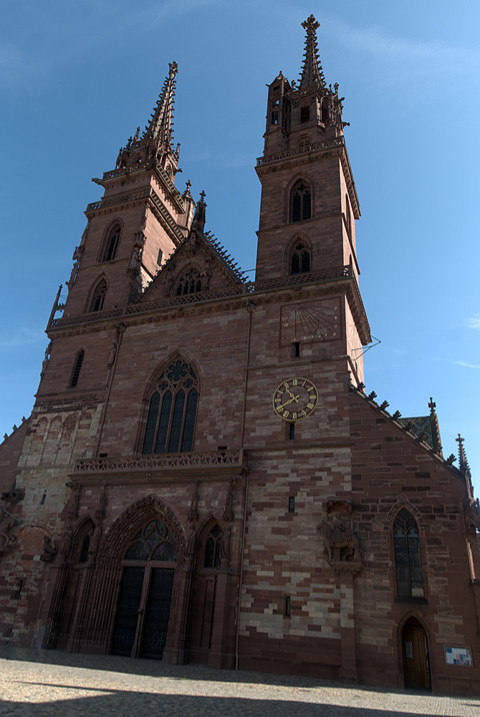 We walked
through the church...
We walked
through the church...
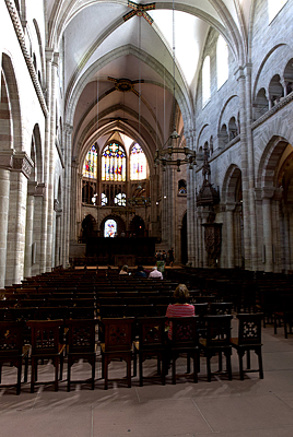
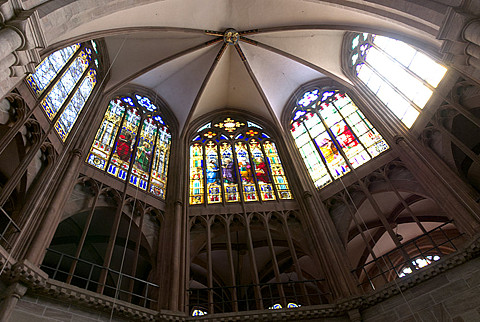
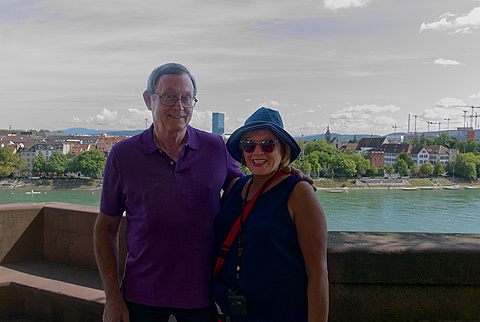
...then walked around to the back and took this picture of ourselves with the Rhine River in the background.
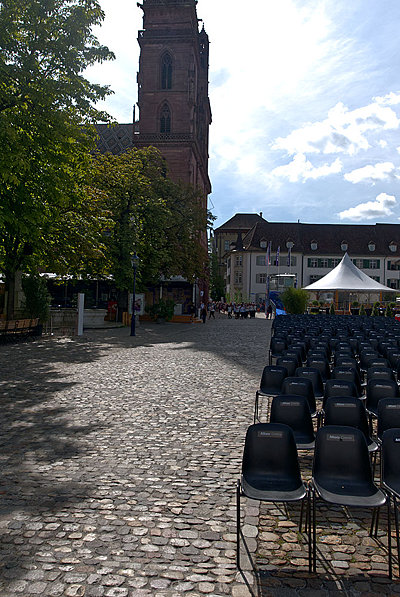 Leaving
Munsterplatz, we took this photo before walking along the river back
toward Marktplatz.
Leaving
Munsterplatz, we took this photo before walking along the river back
toward Marktplatz.
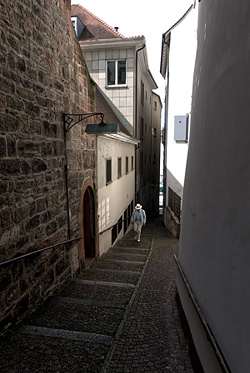 We
were traveling along the high dykes that surround the Rhine River -
to prevent flooding in the city. This is the reason for the steep stairs
down from the top of the dykes to the Marktplatz.
We
were traveling along the high dykes that surround the Rhine River -
to prevent flooding in the city. This is the reason for the steep stairs
down from the top of the dykes to the Marktplatz.
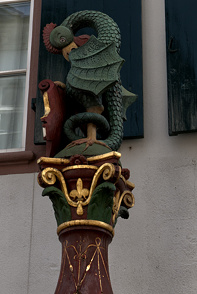 Traveling
along the dyke streets we encountered the Basel city heraldic animal
- the Basilisk - a cock-like bird with dragon’s wings, the beak
of an eagle, and the tail of a lizard (C).
Traveling
along the dyke streets we encountered the Basel city heraldic animal
- the Basilisk - a cock-like bird with dragon’s wings, the beak
of an eagle, and the tail of a lizard (C).
Our tour ended in the Marktplatz, in front of the Town Hall (D) - where we had come the previous evening. Today we wandered the square, bought some chocolate - different from what is shipped to the U.S.A., due to FDA regulations - and decided to take the tram back to our hotel, instead of walking (E).
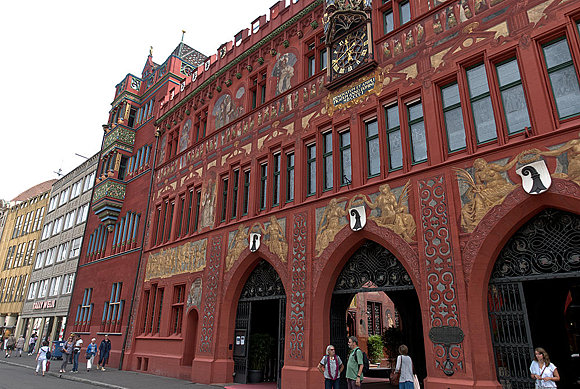
Basel, Day Two - afternoon
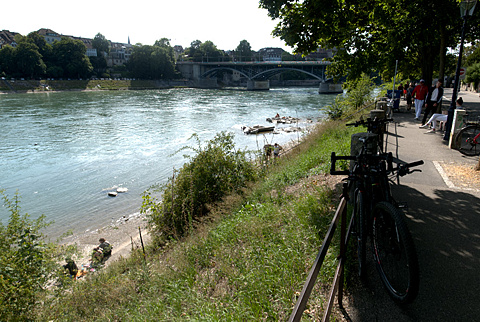
In the afternoon we decided to take a different route to the Rhine,
turn left and walk to the main highway bridge through Basel - the Schwarzwald
bridge.
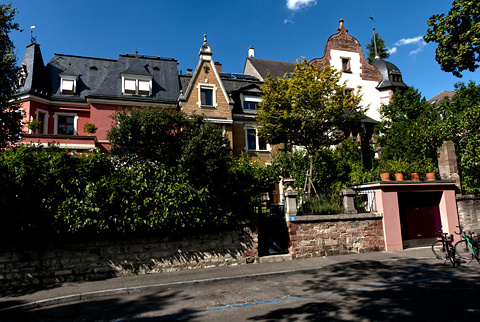
We took pictures of houses along the river - a street and pedestrian access was available along the dyke and all houses were slightly off the river.
The triangular building is the world headquarters of Hoffmann-La Roche, one of several large chemical/pharmaceutical companies that support much of the city of Basel.
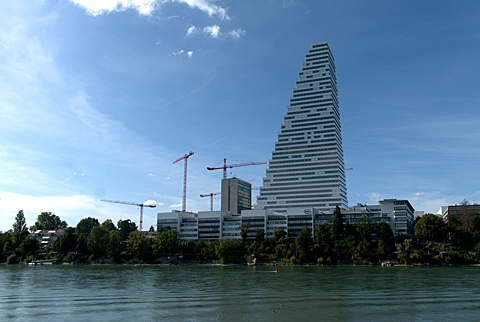
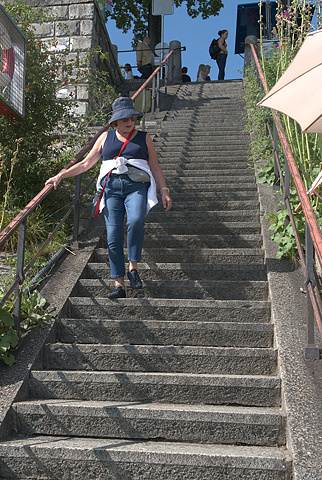
The general design along the river is much different from the U.S., where peoples houses or businesses are right on rivers and river access for ordinary citizens is limited or non-existent.
Taking the steep steps down the dyke (A), we saw many people leaving school/work...
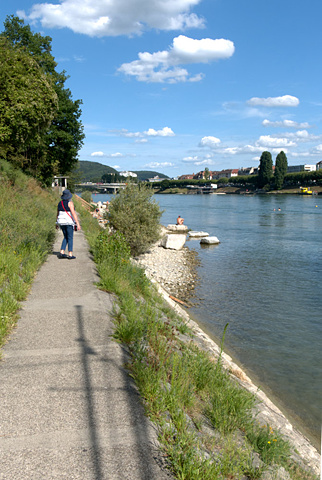
...shedding their clothes for bathing suits, packing it all in plastic ‘fish shaped’ containers, rolling them up until they were water-tight, and using the containers as a float for themselves as they jumped into the Rhine and floated down it.
The current got much stronger toward the center of the river (reserved for boat traffic) was approached (B) and people got as closer to the boat traffic if they wanted to go faster.
Crossing the Schwarzwald Bridge, we walked back along the river’s south side and found the Basel Paper Mill Museum (C) - it had just closed, as it was shortly after 5pm. Patty is looking at the water wheel used to drive the equipment.
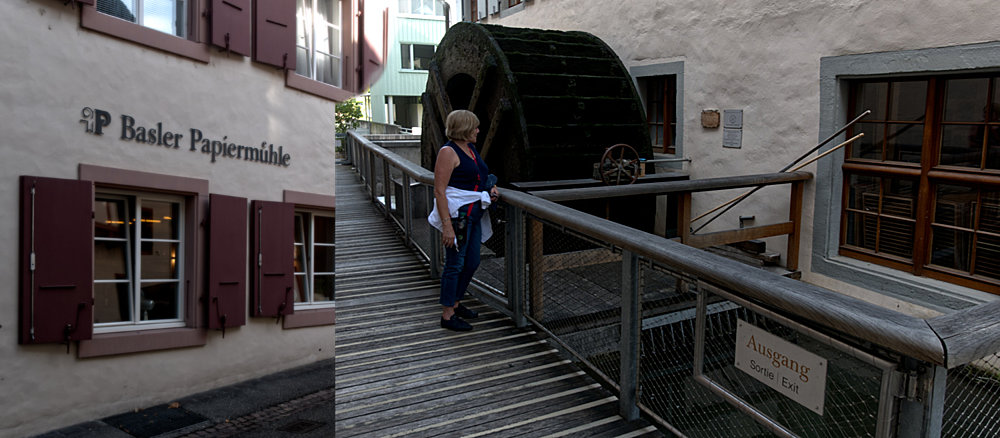
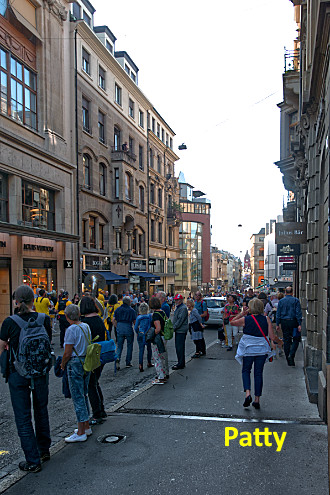
Arriving at Freie Strasse, we saw a number of jazz marching bands forming up and starting to parade down the street (D). This Friday evening was a jazz celebration for the city of Basel and it seemed the entire city population had turned out to celebrate. There weren’t a lot of cars because most everyone used the free tram system to move about the city. Every few minutes a new jazz group would start marching down the street in the direction of the Marktplatz.
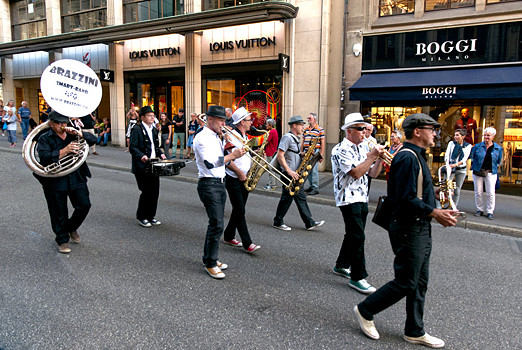
We braved the crowds for over an hour, looking for food. There were jazz groups playing at every corner of the city. In the Marktplatz (E) there were large bands rotating sets - a band was playing Cotten Club music as we walked by.
Squeezing through the tremendously crowded backstreets, we finally found a small restaurant that had a couple of seats available at a family table - Tapas del Mar Spatenburg (F). As small as the restaurant was, even they had a jazz quartet playing in one corner. There was even a second group that took over from the first, half way through the evening. The food was very good and we took our time listening to familiar old jazz tunes.
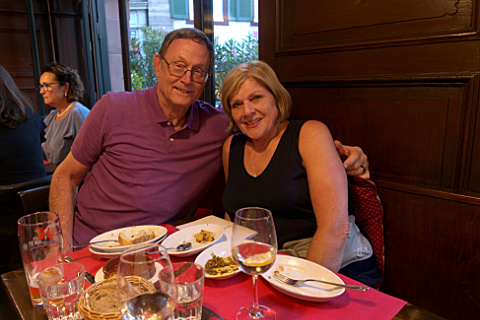
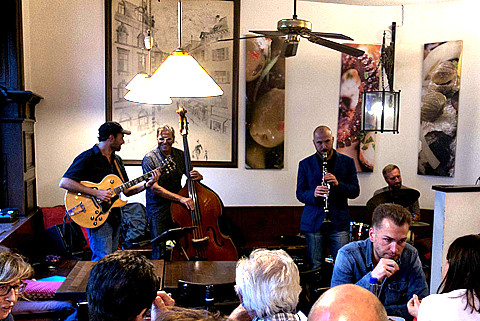
After our 3 hr dinner, we still had to force our way through crowds in the street to get back to Marktplatz and board a tram to our hotel.
Lucerne, Switzerland
Saturday we had an all-day trip to Lucerne planned and we climbed on-board a bus for the 1.5 hr trip through the beautiful Swiss countryside.
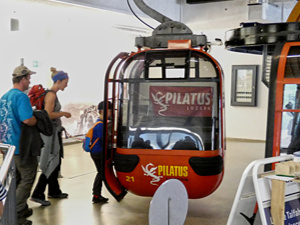
First we were going to ascend to near the top of Mount Pilatus - at almost 7000ft altitude - then descend to Lucerne - about 2500ft. Our trip up was on the Dragon Ride Aerial Cableway, where the gondolas traveled over steep chasms and meadows.
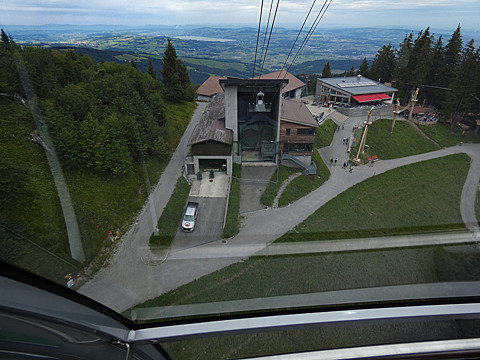
At 4600ft we had to switch from our small, four person, gondola to a large gondola holding 25-30 people. Along the way we passed over hiking trails that went to the peak we were moving toward, parks - everything with a breathtaking view.
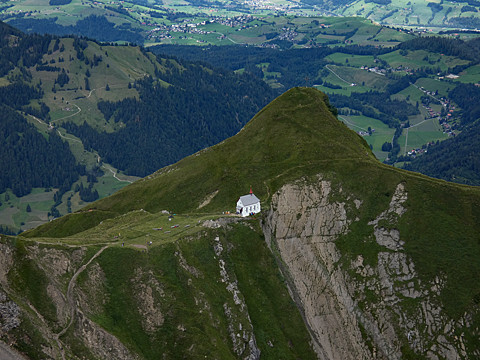
On the way up we passed this church, perched where only a footpath could get to it.
The view from the hotels near the top of the peaks was really spectacular. The Alps in all their glory.
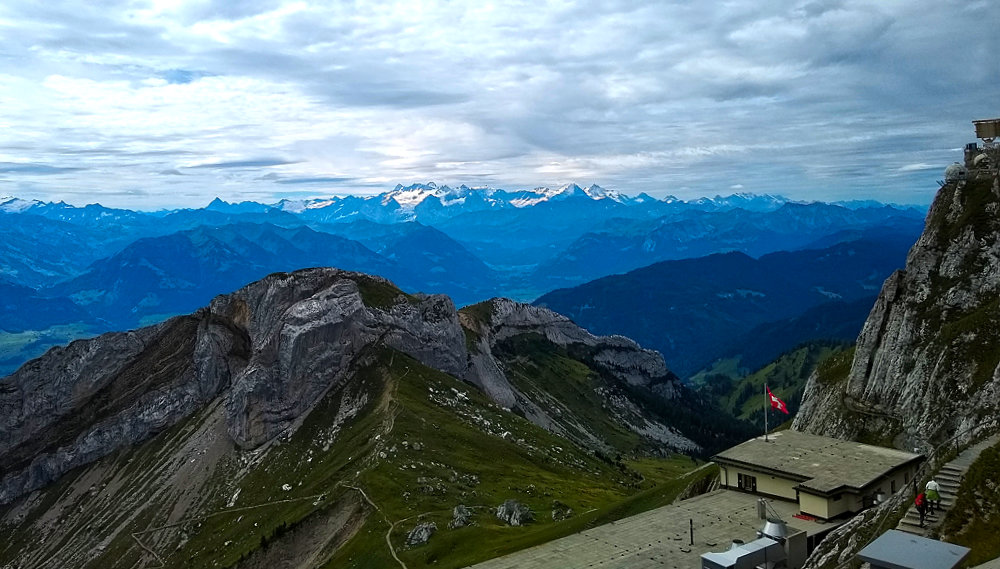
Along with the panorama above, we see Craig & Patty above the hotels below and Patty with a group overlooking Lake Luzern.
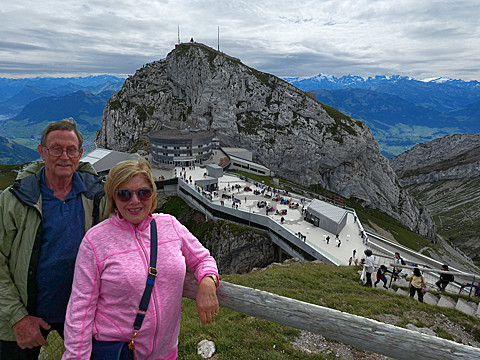
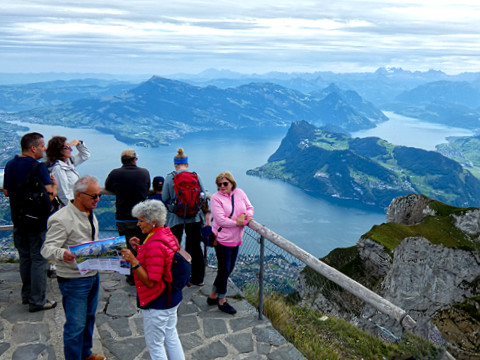
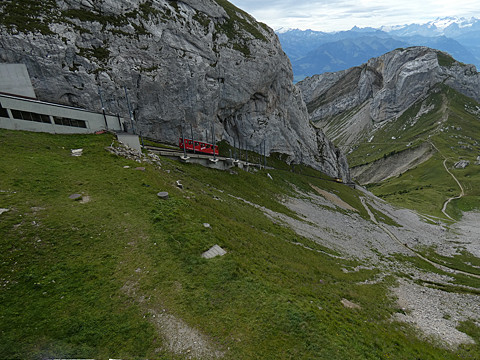
Our return ride was the world’s steepest cogwheel railway down the opposite side of the mountain and here we see it just as it is appoaching the station at the top.
In these two pictures you can see the hiking trails people take to reach this 7000 ft peak, along with the train track down the mountain in the shot below.
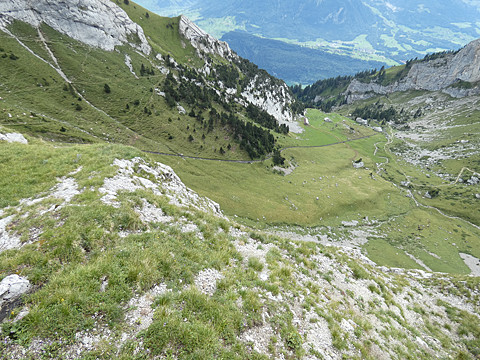
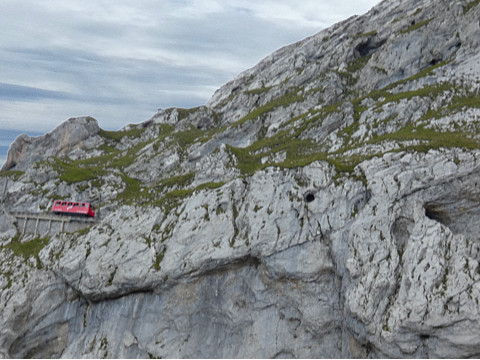
On the return we traveled through short tunnels in the mountain and our railcars were hanging almost half over the steep cliff edges in parts of the trip down.
This following railcar is seen hanging over the edge of the track and about to negotiate a tunnel. You can see the tunnel exit at the right of the picture and an air shaft just to the left of the tunnel opening.
As we neared the station, this was the view from the railcar - the most unique part of our day was nearing an end.
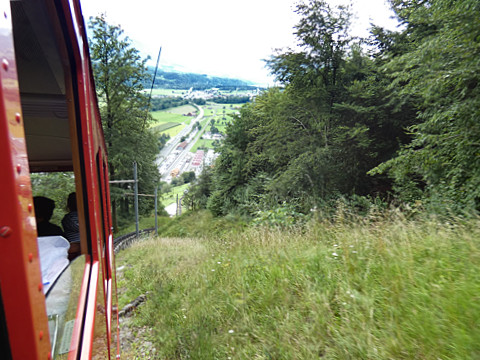
We took this photo of Patty as proof that we did ride the steepest cog railway in the world..
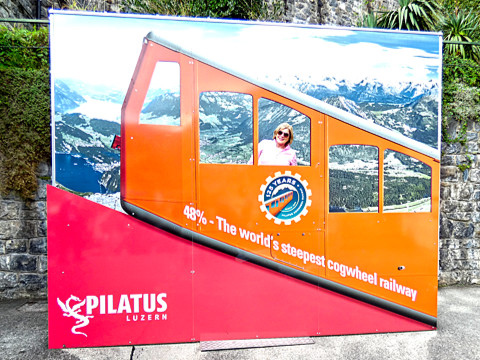
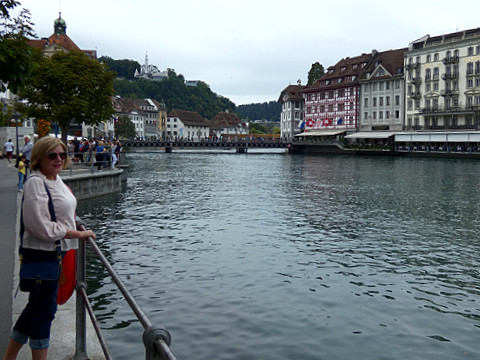
Now it was back to Lucerne and the Reuss River, which ran out of the lake, through locks and a canal to other lakes in the region - we were used to rivers running into lakes, not out of them. Here we see Patty on the Reuss separating the city of Lucerne.
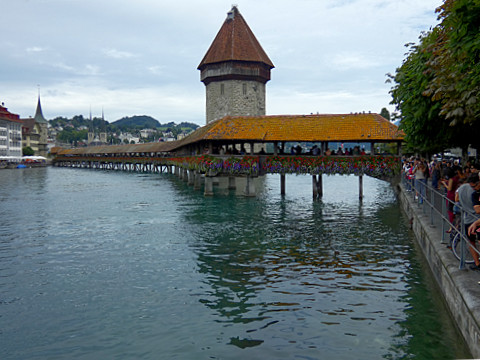
One side of Lucerne is the old city and one the new side - of course new, being in the 13th century, is a relative term. The Kapellbrücke (literally, Chapel Bridge) is a covered wooden footbridge rebuilt in the 17th century, spanning the River Reuss diagonally and connecting the old part of the city with the newer part. It is the oldest covered bridge and the oldest truss bridge in Europe. The connection between the two sides of the city was necessary to move men and equipment if the city was attacked from the lake side.
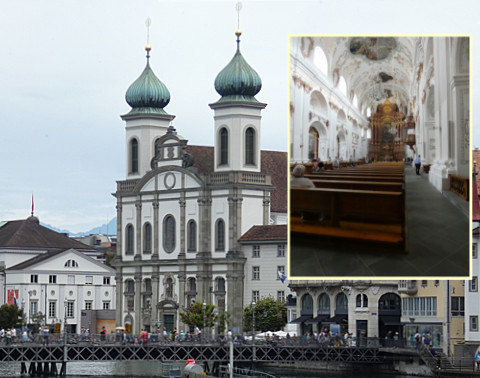
The Jesuit Church Cathedral is located near the Chapel Bridge on the Reuss River.
No trip to Lucerne would be complete if we didn't stop at the Lion Monument, an homage to the 1000 Swiss Guards who lost their lifes protecting French King Louis XVI in 1792. Built into the side of a stone mountain face, the setting in a park is very moving.
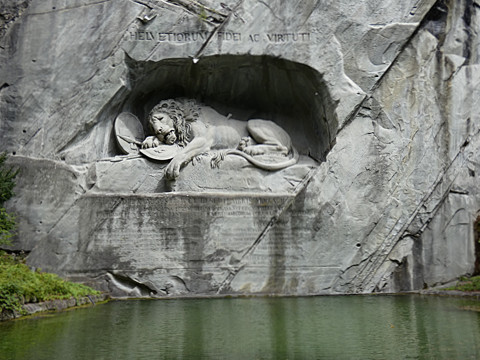
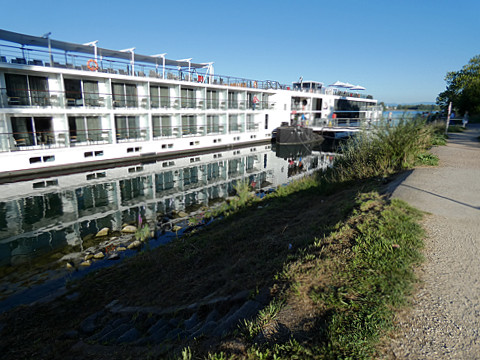
Arriving back in Basel, we were taken directly to our Viking River Cruise boat, the Tialfi.
The three floors this side of the entry way are sleeping quarters, while the space the far side of the entrance is for crew, the dining room, and the lounge on the 3rd floor - yes, the first floor seems like it is almost under water. We were on the 2nd floor and were still just a couple of feet above the water line. The 4th floor is the roof and it is for open air cruising plus where the captain's wheelhouse is located.
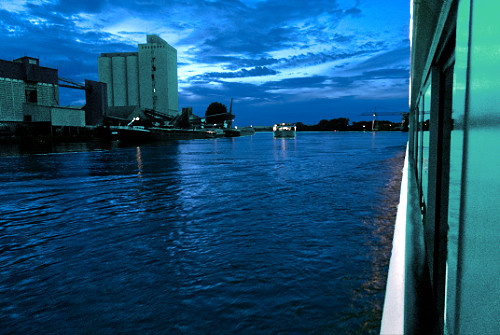
Night was quickly coming on as we left Basel. On our first night, the boat entered Germany - almost as soon as we left the city - and we went through four locks, only the first of which were we awake to directly experience. There were a total of 11 locks we passed through on our way from Basel to Amsterdam seven days later.
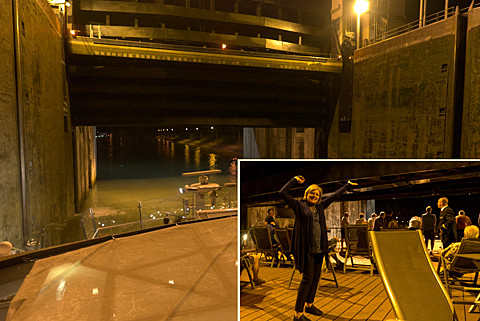
Here we see the boat starting to exit the first lock, the water having already been lowered, and we also see Patty celebrating going through the lock. Patty could touch the bottom of the gate wall as we passed underneath it.
How does the Captain's wheelhouse make it through a lock that barely clears the people on deck? Why it simply drops into the top deck - that's how! The Captain can navigate the boat through the locks by means of controls located on either side of the boat - shown here to the left of Patty and the other passengers during a later tour of the wheelhouse.

Breisach, Germany, the Black Forest, and Colmar, France
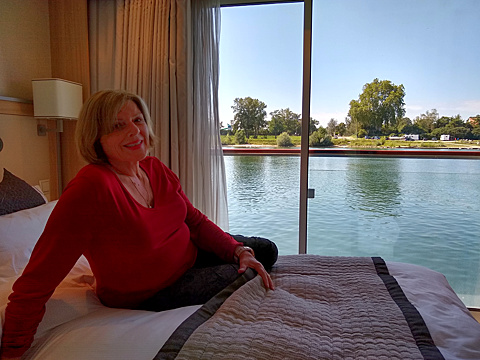
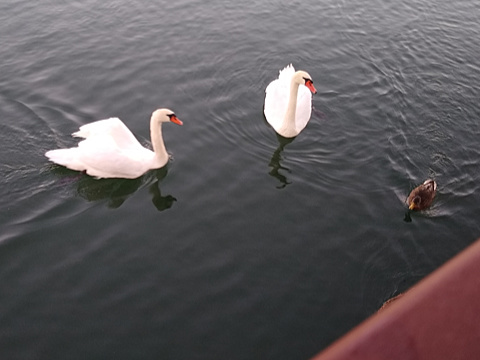
Sunday we awoke in Breisach to Swans swimming outside our bedroom window, less than a yard away. Ahhh! What a pleasant way to wake up.
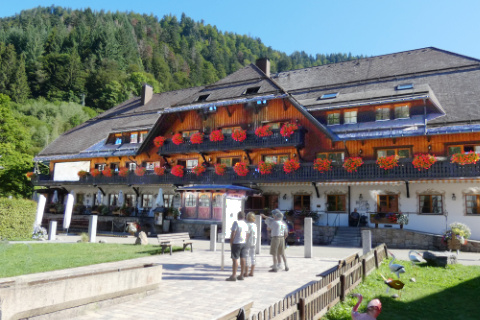 After breakfast in the dining room, we set off for a tour of the Black
Forest part of Germany. Our tour took us through the rolling countryside
leading into the Black Forest - so named because the trees are so thick
the sunlight has a hard time working through to the ground. We traveled
over route 294 and down 500 to reach the Hofgut Sternen hotel, where
Patty went to see a cuckoo clock demonstration...
After breakfast in the dining room, we set off for a tour of the Black
Forest part of Germany. Our tour took us through the rolling countryside
leading into the Black Forest - so named because the trees are so thick
the sunlight has a hard time working through to the ground. We traveled
over route 294 and down 500 to reach the Hofgut Sternen hotel, where
Patty went to see a cuckoo clock demonstration...
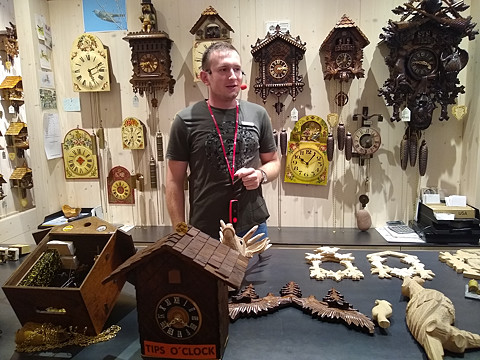
...and Craig went hiking to a waterfall on the Ravenna creek. During this hike he passed under the Ravenna Bridge, constructed in 1885, and used for railway traffic ever since. It was partially destroyed by retreating German troops near the end of WWII and repaired in 1948.
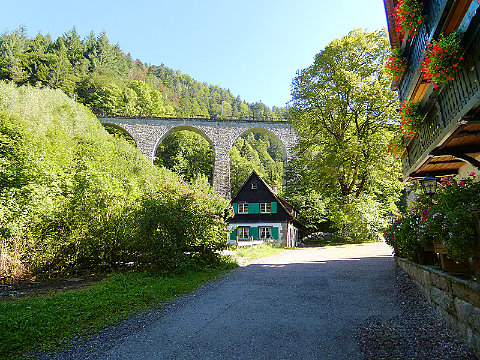
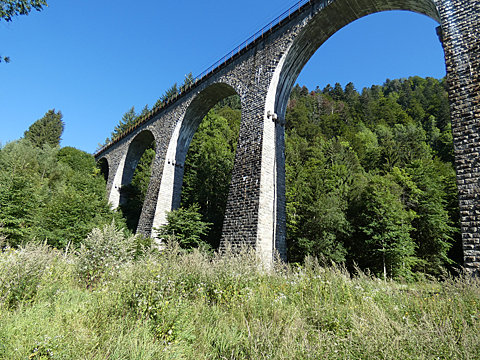
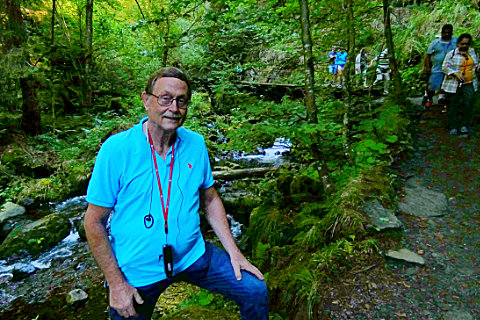
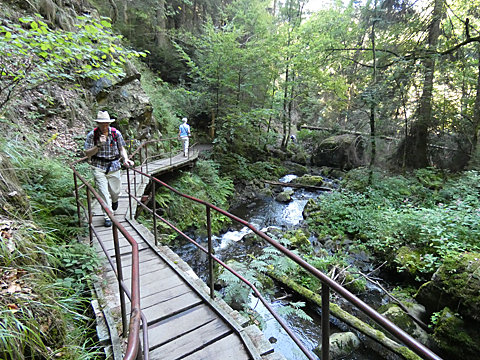
Craig & Patty met up again to witness the making of a Black Forest Cake - of course each did sample a piece - fantastic. Note that the cake was cut before the final decorations were applied - the cake cutter is in front of the baker as he worked.
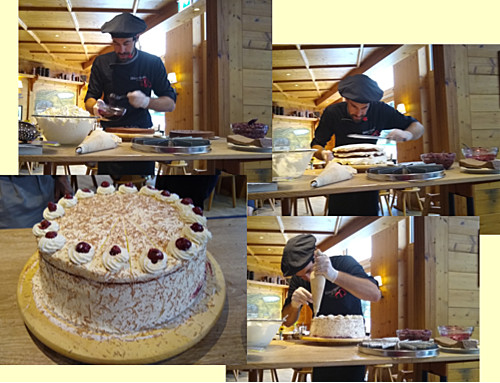
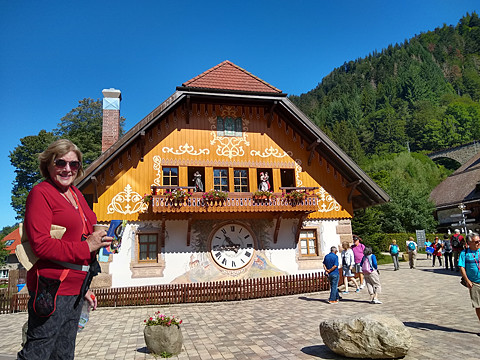 Finally,
Patty posed in front of the local museum before boarding the return
bus.
Finally,
Patty posed in front of the local museum before boarding the return
bus.
The City of Colmar, France
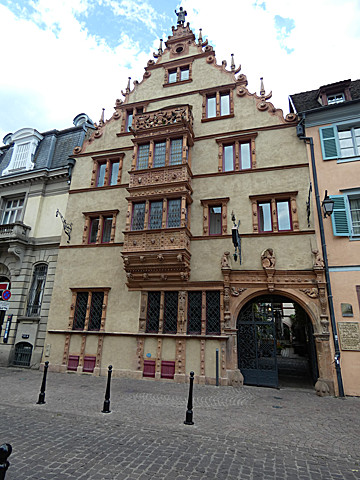
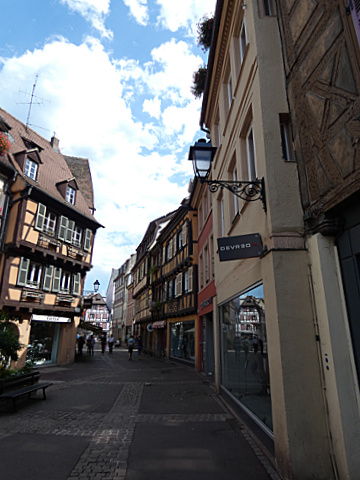
Returning to the boat, we quickly ate lunch and set off on another tour of the medieval village of Colmar, France. It was an interesting walking tour through a city built long, long before the thought of cars and the design of streets and buildings was quit interesting.
The first building illustrates that people could build multiple stories in medieval cities.
On the right is a typical street, where taxes were based on first floor square footage. Therefore people expanded the building footprint as they added stories.
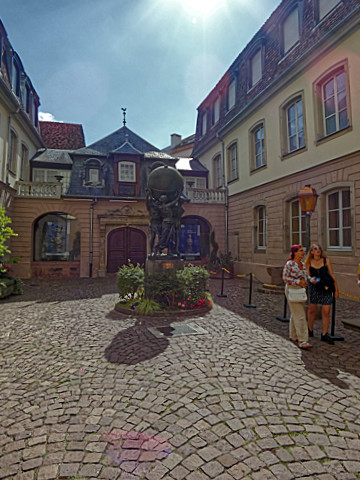
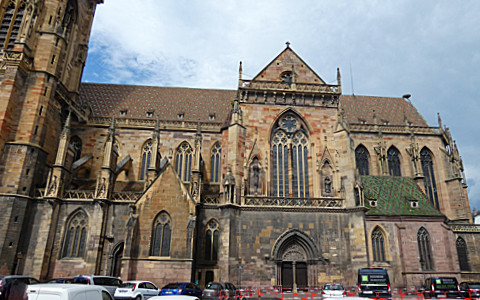
This is the birthplace of Auguste Bartholdi - the sculptor of the Statue of Liberty - and his house is a museum of his work, both painting and sculptures. The most interesting thing about his sculpture exhibits is they show most of the preliminary sculptures made in planning his large works - including the Statue of Liberty.
On the way out we passed the St. Martins Cathedral.
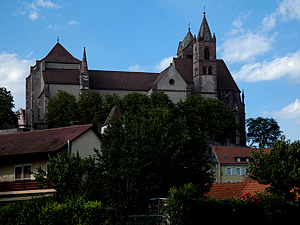
Upon return to our boat, we passed this beautiful church as we were cruising down the Rhein, then...
...we started through another lock while eating dinner at the bow section of the lounge on the 3rd deck.
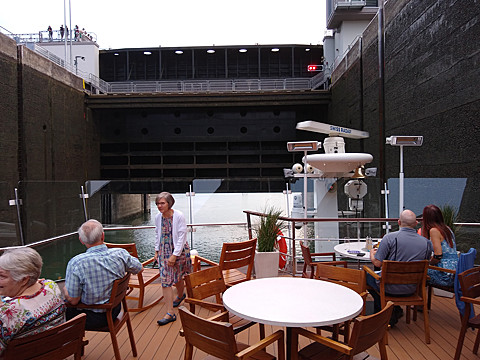
Strasbourg, France
On Monday we toured a section of Strasbourg that went back to medieval times. The entrance to this old part of the city was over the canal below. The fountain commemorates the Roman aquaducts that were a key part of building the original population center on this site.
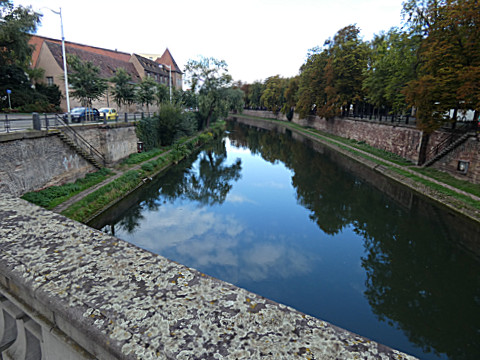
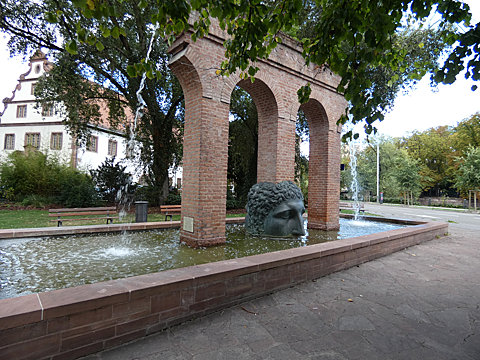
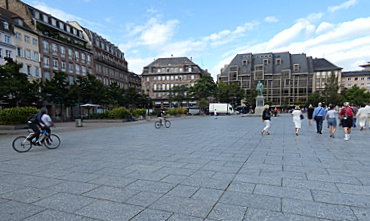
The huge, open space squares are the defining feature of European cities over their American counterparts. They are incredibly useful when holding civic events, farmers markets, or just accommodating social gatherings.
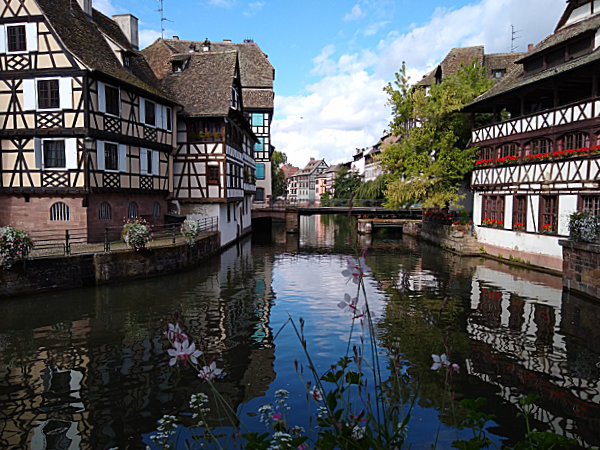
Here we see Craig making his way through the streets inside the canals defining the old city of Strasbourg.
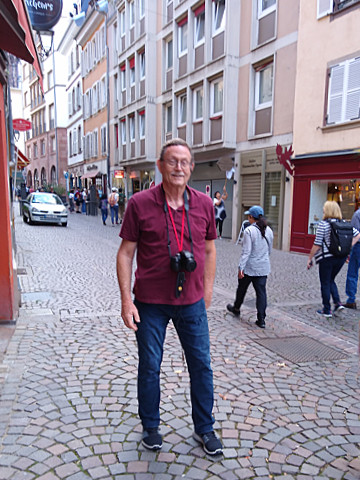
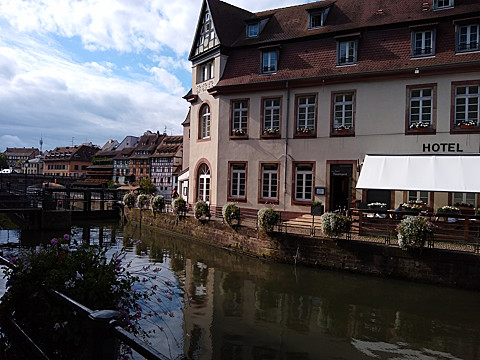
These beautiful homes were representative of what was found in old town Strasbourg. The most impressive buildings were built on the canals.
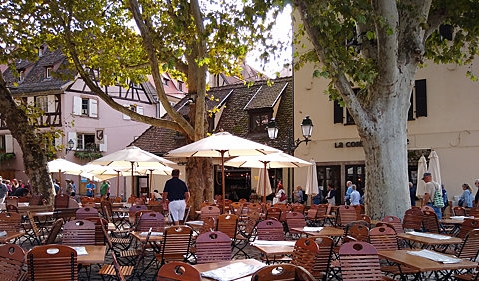
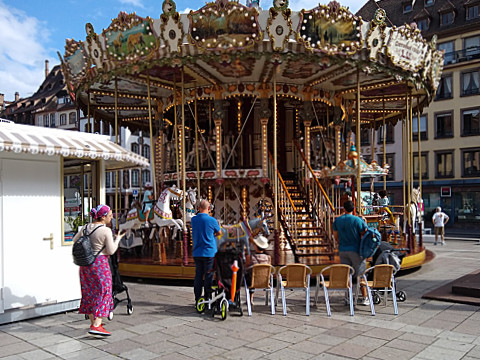
Above is a small Strasbourg square surrounded by resturants and merchants. To the right is another square containing a merry-go-round.
Our last stop was at the Notre Dame Cathedral in Strasbourg.
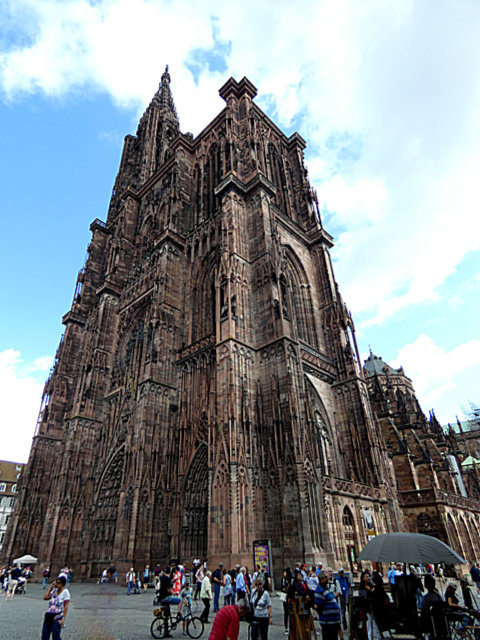
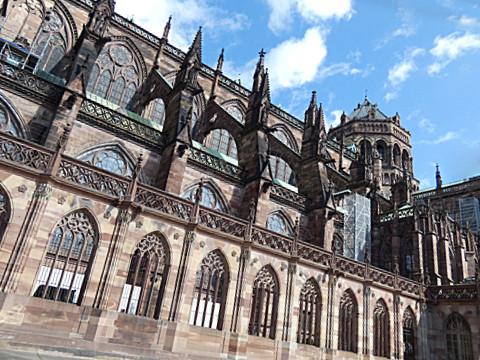
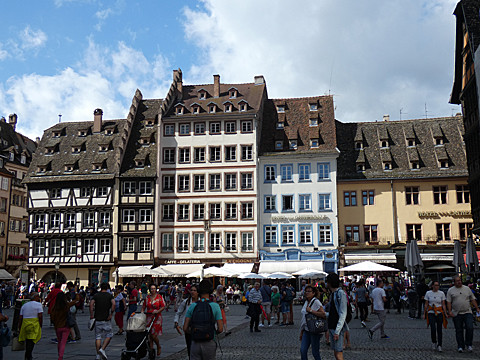
In a very confined space, this cathedral is impressive. Of course the flying butress design is a highlight, but the buildings in the square surrounding Notre Dame are also noteworthy.
The inside was just as grand.
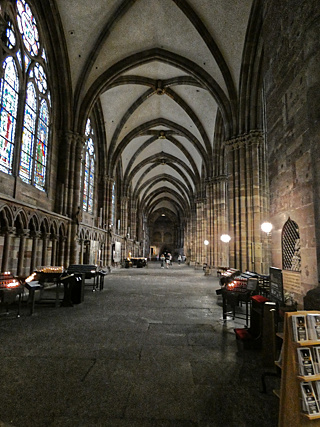
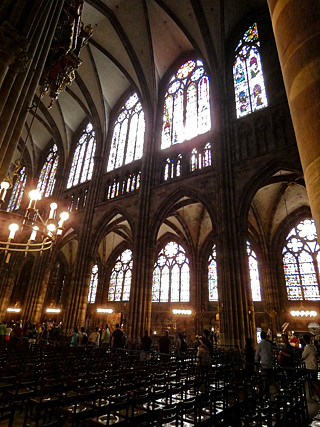
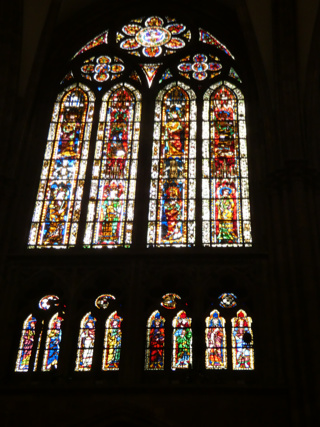
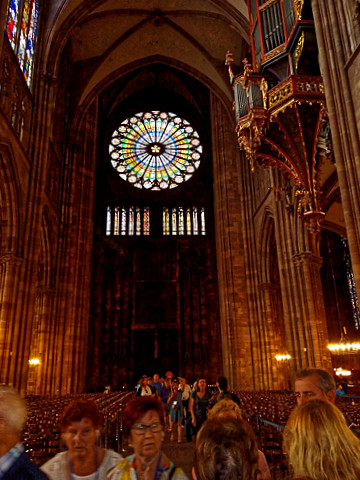
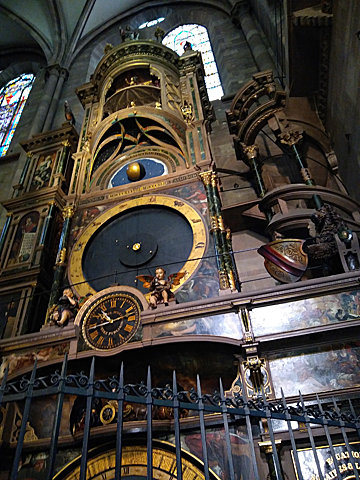
Upon returning to the boat, we set off to walk through the small river city of Kehl, Germany, where the boat was docked. We walked through the park lining the Rhine and through a residential neighborhood to the main street of Kehl. Here the open pedestrian shopping streets looked more familiar to us Americans, but there was another open space square in the middle of everything - encouraging everyone to simply gather and talk or sit, as they chose.
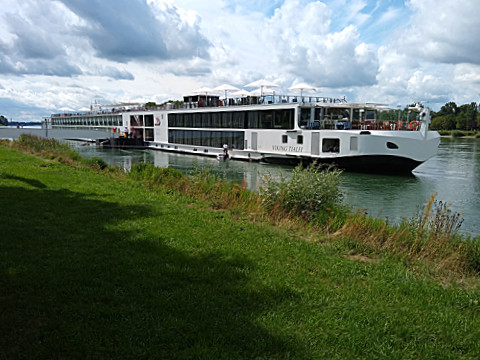
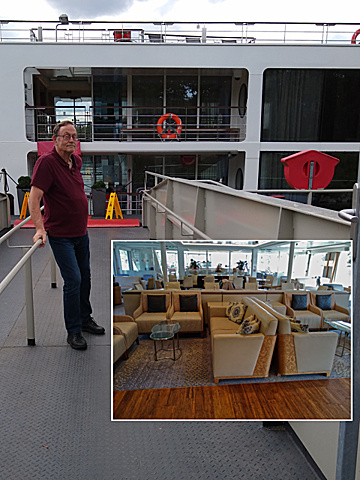
This picture of the Tialfi more clearly shows the front half of the boat, illustrating the dining area on deck 2, plus the lounge and forward eating on deck 3.
Craig holds down the entrance.
View of the lounge on the 3rd deck, looking forward.
Before we left, we got the Captain's tour of the micro-sized bridge - it sure has a lot of equipment.
The other picture is of the first mate using one of the secondary bridge control sets - for traversing the locks with the bridge lowered.
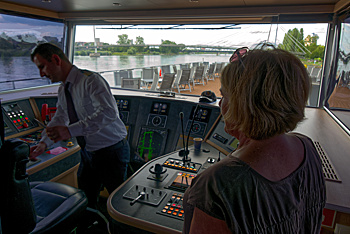
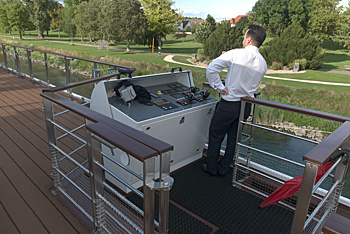
Heidelburg & Rudesheim, Germany
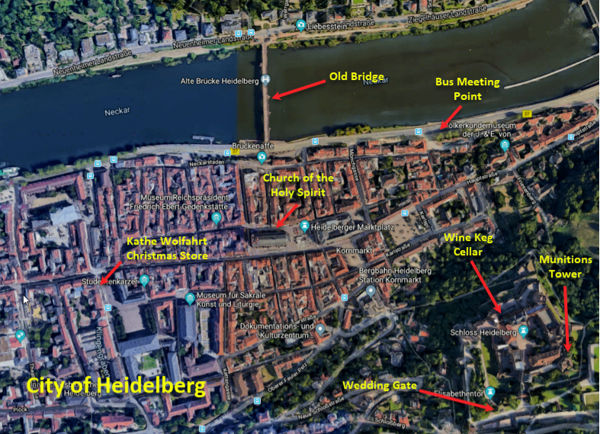
Tuesday the boat dropped us off for a bus trip to the Heidelburg Castle and later to the bus meeting point for casual sightseeing and shopping.
The first stop was the castle
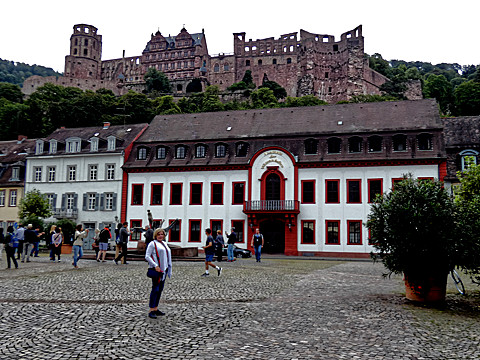
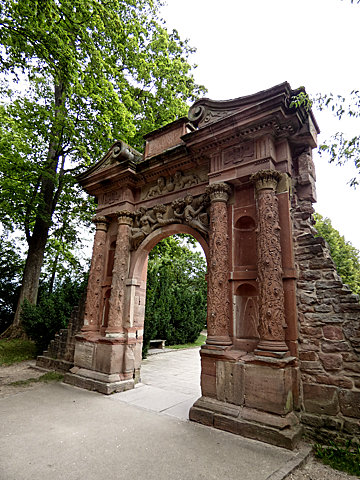
The castle, high above the city, is in ruins, but one side of it can be reached through the arch refered to as the Wedding Gate.
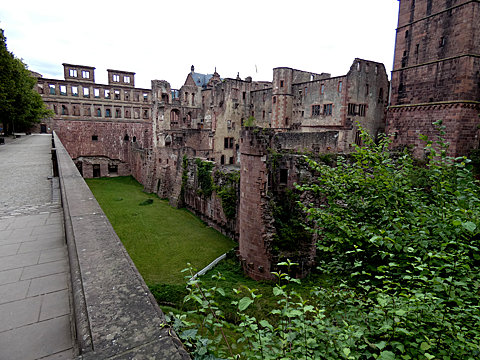
This overlook of the east wall and a pasture where cattle grazed can be viewed just after you walk through the Wedding Gate.
The northwest corner of the castle was the place where munitions were stored. Of course the inevitable happend and below is what was left.
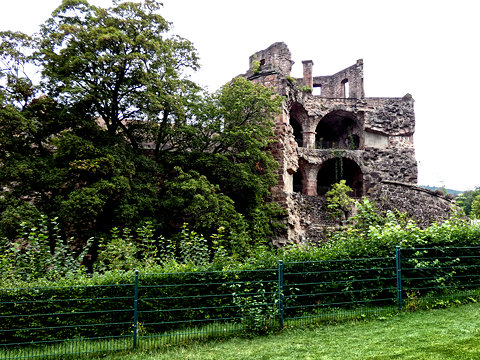
There are a few rooms that can be visited and we went to the wine cellar, where the largest wine cask in Europe is stored - no wine, of course, but we got to take pictures.
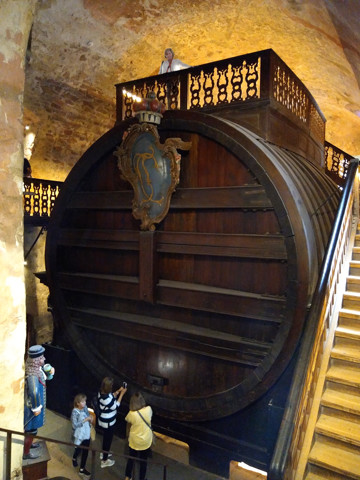
You can see Patty standing at the top of the cask.
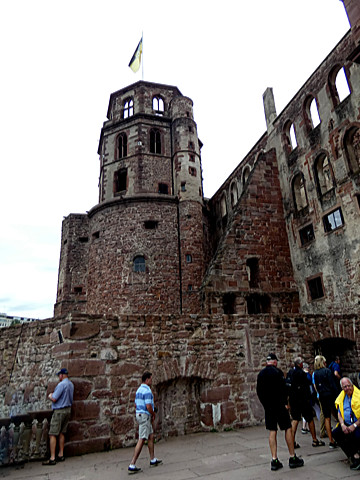
The tower shown here is the far left tower visible in the picture of the castle from the city - shown in the first picture above.
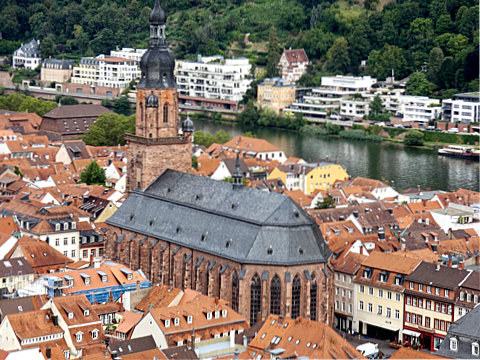
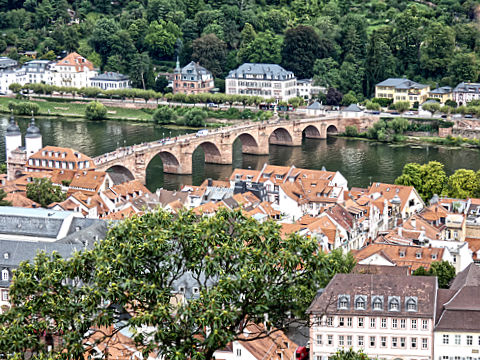
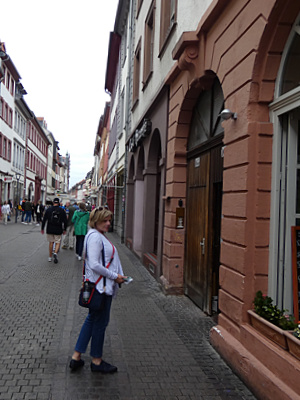
The city is layed out below the castle, with the Church of the Holy Spirit forming one side of the Heidelberger Marktplatz and the ‘old bridge’, shown on the right, connecting the city across the Neckar River.l
The bus took us down to the tourist bureau and we walked from there up Hauptstrasse, past the Heidelberger Marketplatz and the Church of the Holy Spirit, to Universitatsplatz, where we visited the famous Christmas store Kathe Wohlfahrt. On our way back we were window-shopping and Patty had to stop at Josef Seibel to buy a pair of shoes.
The bus picked us up and took us to where the boat had moved in our absence, then left as soon as we arrived.
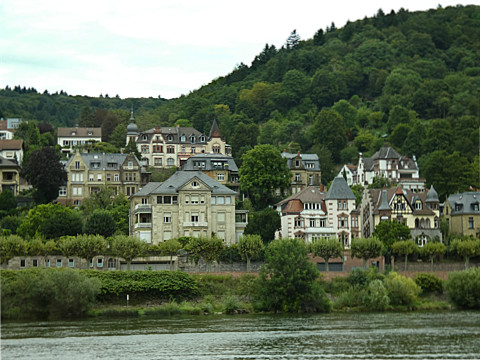
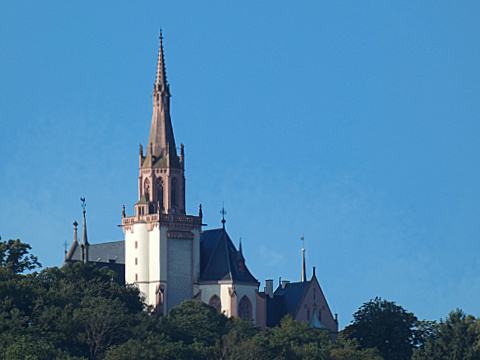
Cruising the Rhine, we saw homes and churches, plus a few castles. We would be stopping for the night in Rudesheim and tomorrow would be spending the morning on deck looking at all the major castles between Rudesheim and Koblenz.
We arrived in Rudesheim around 5pm and chose to wander the town ourselves, instead of taking one of the optional tours. The town was interesting, but we were getting tired of cobblestones. We stopped to purchase a couple of Rudesheim coffee cups - we had learned to make coffee with Asbach brandy this afternoon on the trip here - then returned to the boat to relax.
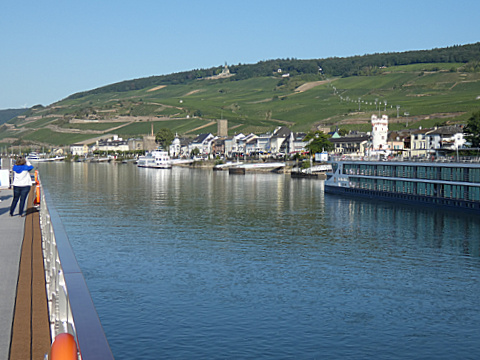
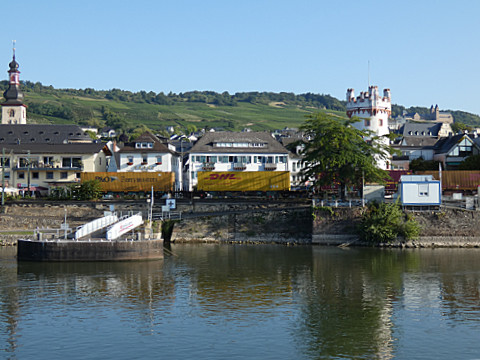
Cruising the Rhine & Koblenz, Germany
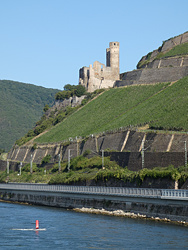
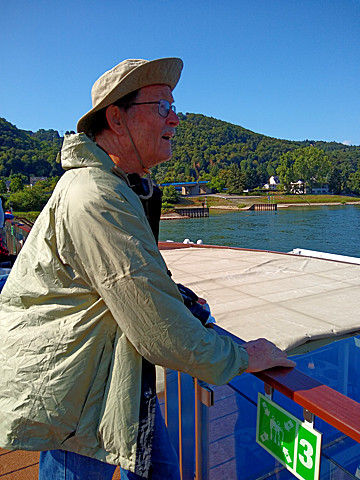
From 8:30, when we left Rudesheim, until our arrival in Koblenz at 1:00, we passed many of the castles built along the Rhine. We photographed and identified seventeen of them. They are all shown here, so you may simply scan through the castle pictures, unless there is something specific you are looking for.
Craig is in charge of photographing and keeping track of all the castles we pass. However, Patty took some of the best scenic pictures.
On the right is the Ehrenfels Castle, seen just as we are leaving Rudesheim and taking a sharp right turn on the Rhine.
The first picture below is of cruisers sitting on the top deck, looking at the ships traveling the Rhine, the castles, the towns, and the beautiful scenery on this clear morning of cruising.
The Rheinstein Castle, the Reichenstein Castle hotel & museum near Trechtingshausen, and the Sooneck Castle are in the first line.
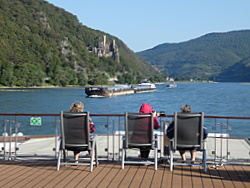
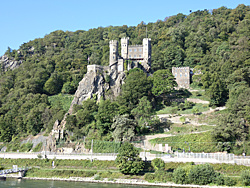
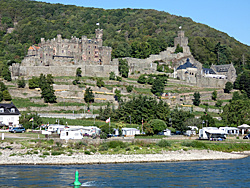
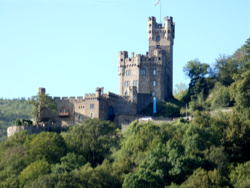
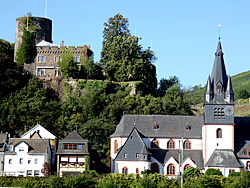
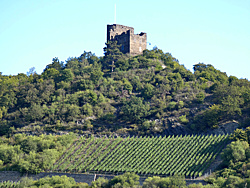
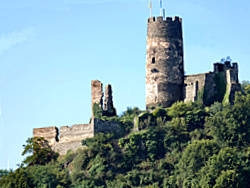
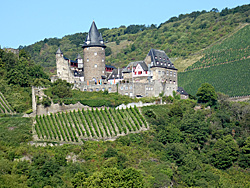
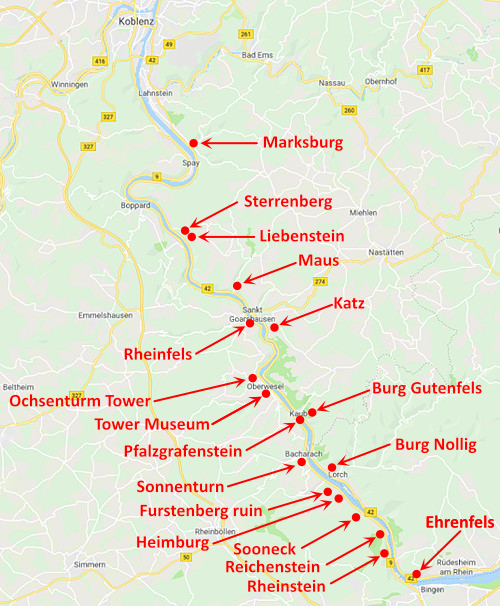
The Heimburg Castle in Niederheimbach, the Furstenberg ruin (note the vertical vinyards in two of these pictures - more efficient drainage for the grapes and seen up and down the Rhine), the Burg Nollig Castle above Lorch, and the Sonnenturn Castle near Bacharach
All the castles we photographed are identified and located on the map to the right.
Four-and-a-half hours of open cruising - this morning gives the entire cruise its name and character.
The town of Kaub was a customs stop and the Pfalzgrafenstein Castle was located on a bar in the middle of the river - to stop travelers, while the Burg Gutenfels Castle is on the side of the hill. The town of Oberwesel has the Tower Museum sitting above the Liebfrauenkirche, plus the Ochsenturm tower in front of Pfarrkirche St. Martin.
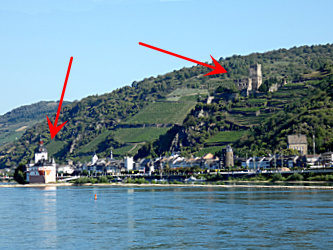
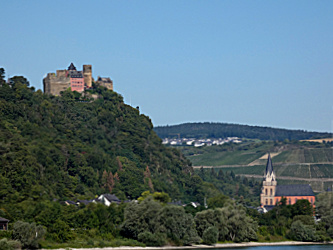
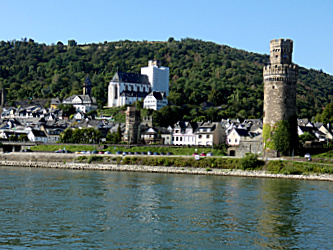
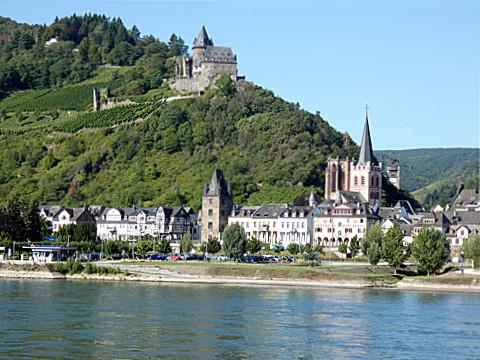
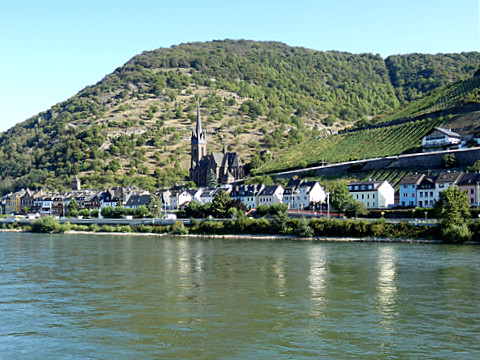
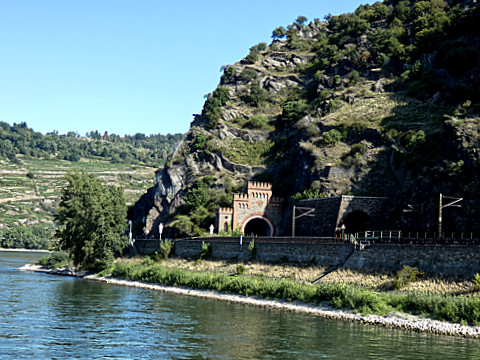
The town of Bacharach is shown with the Sonnenturm Castle above it. Next is shown the nearby town of Lorchhausen, with the catholic church of St. Bonifatius. Finally, on the other side of the river from Oberwesel, castle-like structures are constructed around tunnel openings. This was done by the Germans in WWII because the allies agreed to try not to bomb the historical castles along the Rhine - train tunnels were prime targets, however.
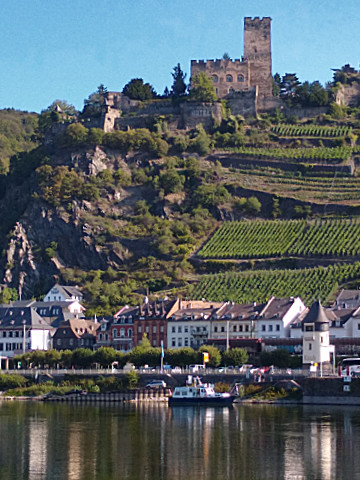
Patty took this beautiful picture of the Burg Gutenfels Castle in the town of Kaub. The castle, the vinyards, the town, and the river are well framed in this unforgetable memory of the scenic Rhine River.
Below we see Patty as we cruise by the town of Hirzenach, just before we reached the enemies castles.
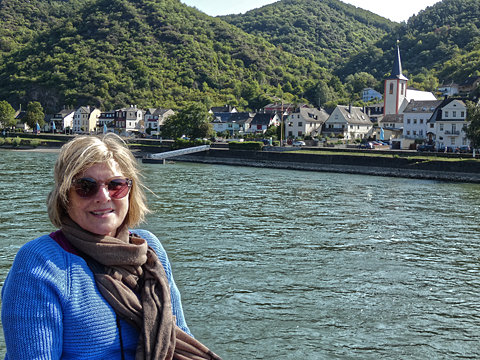
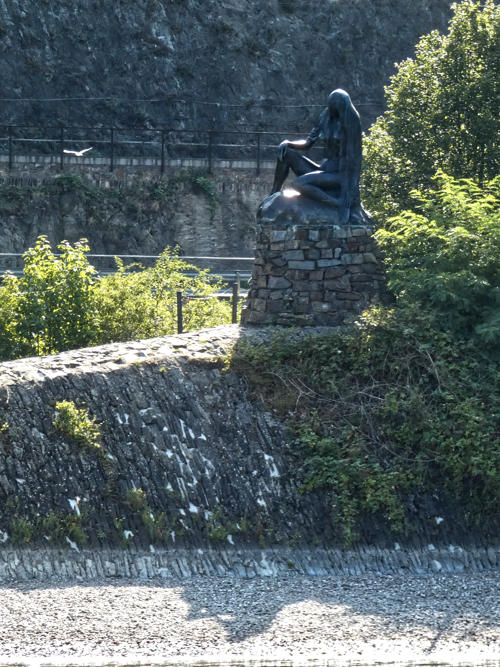
Approaching the famous Lorelei Cliff we learned this is the narrowest part of the Rhine River and everyone was particularly careful when passing each other on this bend. As we passed the cliff, we saw the Lorelei Statue commmorating all the sailors who lost their lives on this part of the river.
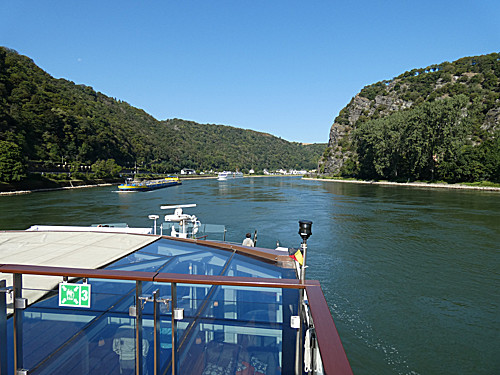
The town of St. Goar has two castles - Katz and Rheinfels, while further downriver the Maus Castle is failrly remote. The Sterrenberg and Liebenstein Castles are called the enemies castles because two brothers built them next to each other and constantly tried to take over the other's property. There is even a fortification wall between the two castles.
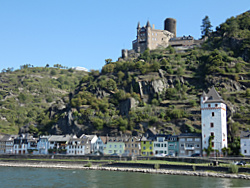
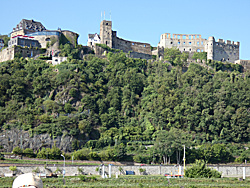
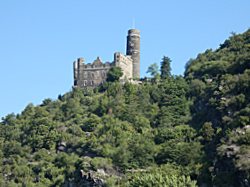
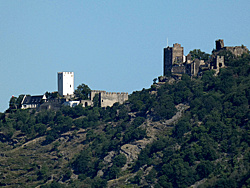
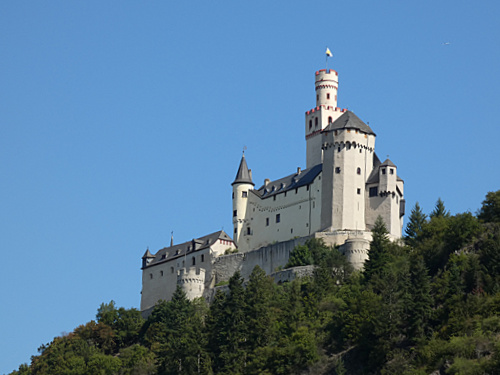
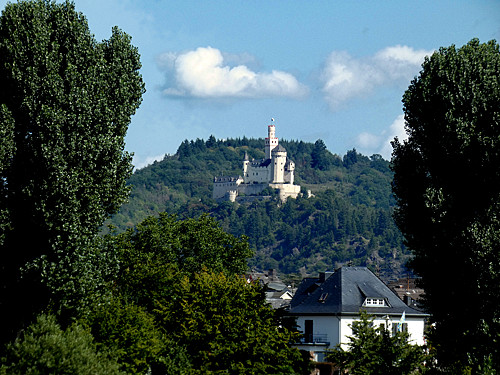
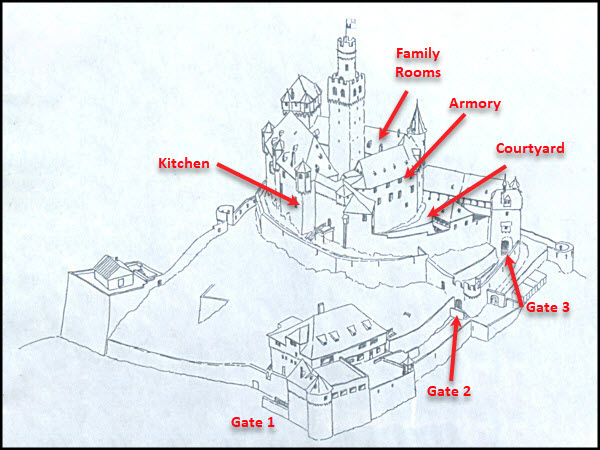
Marksburg Castle was the final castle we photographed. As soon as we docked in Koblenz we left on a tour of this castle and pictures of the inside are shown below.
Inside Marksburg Castle
This is a well maintained castle that has never been destroyed. The initial building that now holds the Armory was started in 1238, the Tower in 1372, the courtyard and kitchen started construction in 1589, and the Family Rooms were finished in 1706.
In 1900 it was sold to the German Castles Association and it has been their headquarters ever since.
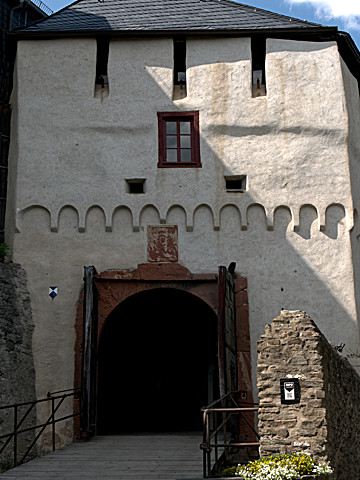
This is the initial entrance to the castle - Gate 1. As you pass through this initial gate and look back, the view you would see is below, followed by a view of Gate 2 from the area between Gates 2 & 3.
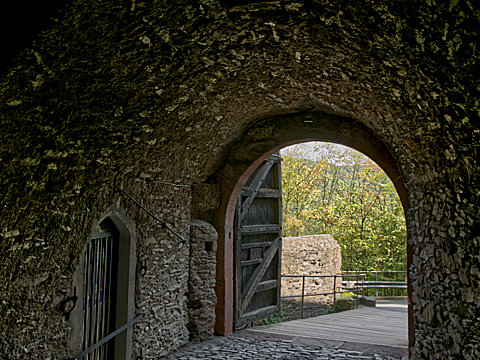
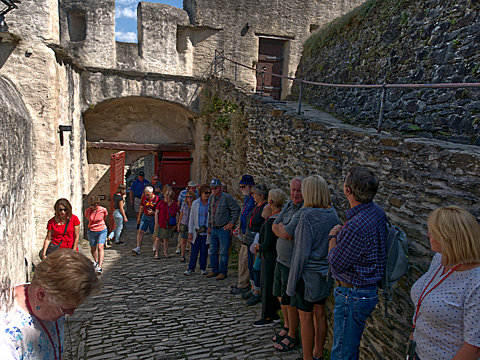
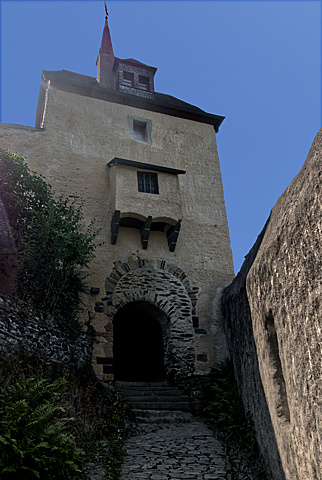
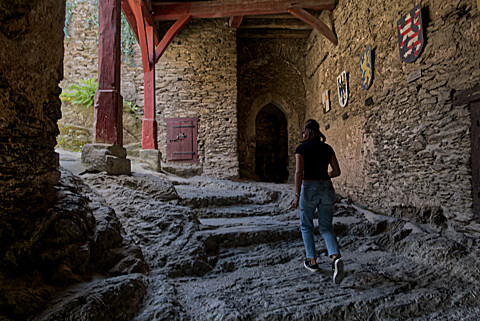
Here we see Gate 3 and the path curving upward to the entrance courtyard. All this is to insure that any invaders pay very dearly before they are able to penetrate the castle.
The door straight ahead is the entrance to the blacksmith's area. It is located here, amid all the stonework, so that the shop is within the castle, but the necessary fires are separated from woodwork found throughout the castle.
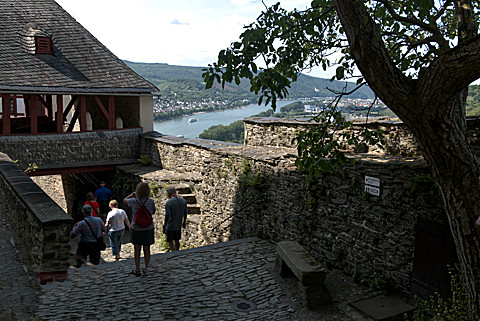
The courtyard is entered through very roughhewn stairs - necessary for horses and riders as well as people.
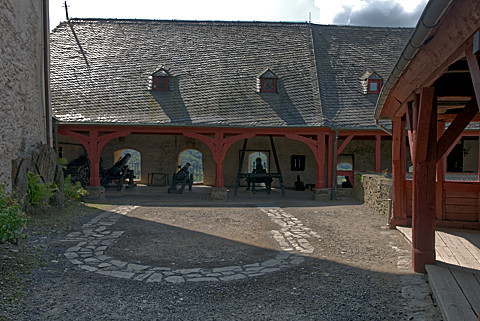
This courtyard also houses cannon and faces the Rhine River, allowing the shelling of boats trying to navigate or cross the river.
Below you see the view of the Rhine from the courtyard area.
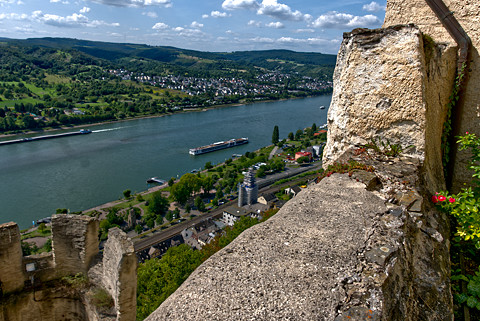
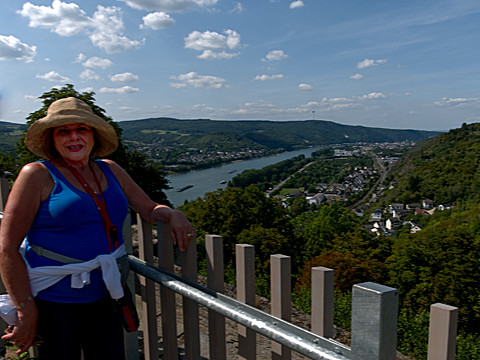
Any castle under siege needs a garden inside to allow the residents to continue to eat fresh vegetables. The other necessary staple is wine, beer, or other fermented beverage. Here we see the storage area for wine casks. Then there is a large kitchen area, with lots of utensils of all kinds.
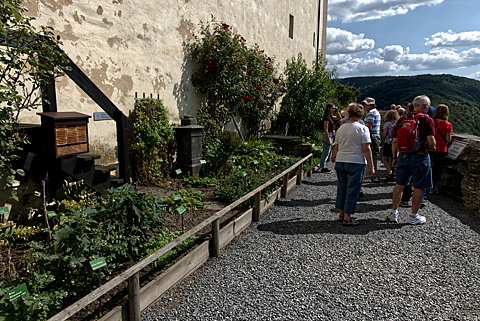
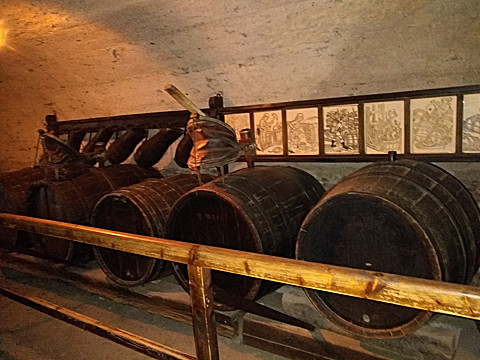
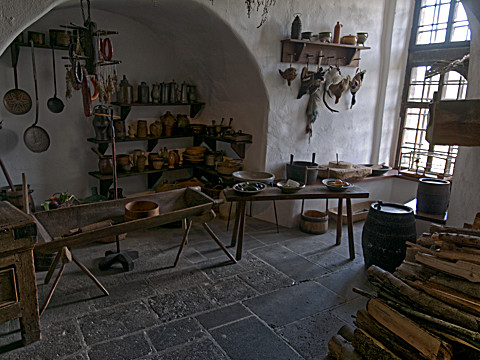
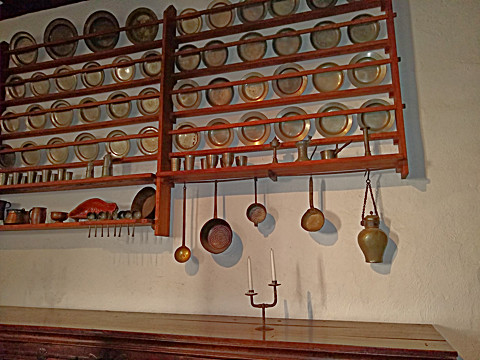
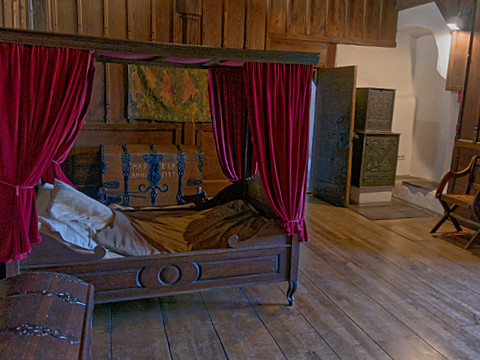
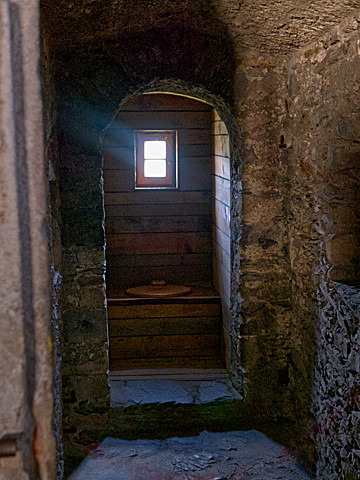
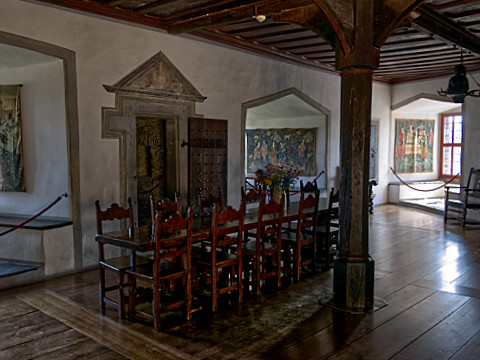
Moving to the living quarters, there was lots of space, but the beds were small.
The toilet was placed off the dining room so that fecal matter would fall outside the walls, perhaps to be picked up and used by the gardners.
The toilet entrance can be seen in the center of the dining room on the left.
A chapel was build next to the dining room, but outside the living area, so that it could be claimed it wasn't part of the household.
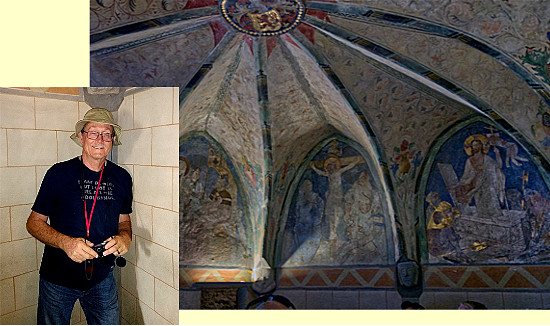
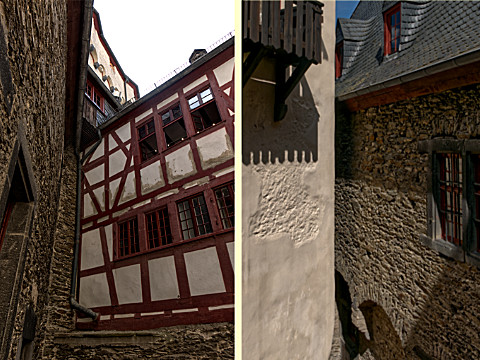
Here we see an inner courtyard that shows all the different parts of the castle that were built centuries apart. It is a little hard to visualize, but this relatively small space was like standing in the middle of several different tenement houses, all crammed together.
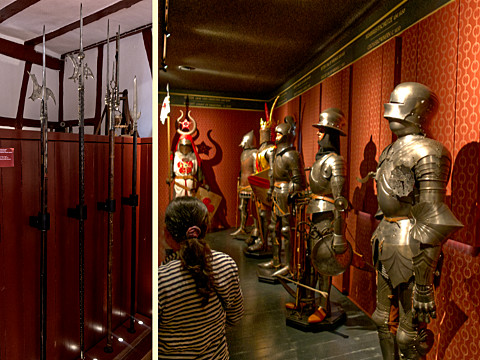
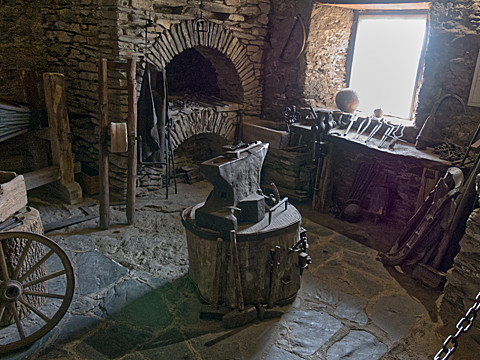
Above is a museum-like room where various weapons were stored. Also, a history of the development of suits of armor was very interesting.
Finally, we walked back down to Gate 3 and visited the blacksmith's shop. Note that there is no wood kept here. Fire was a major concern in any medieval castle.
Koblenz, Germany
The boat was leaving for Cologne at 3am Thursday morning, so we decided to walk around the town. The map shows our path and the pictures we took.
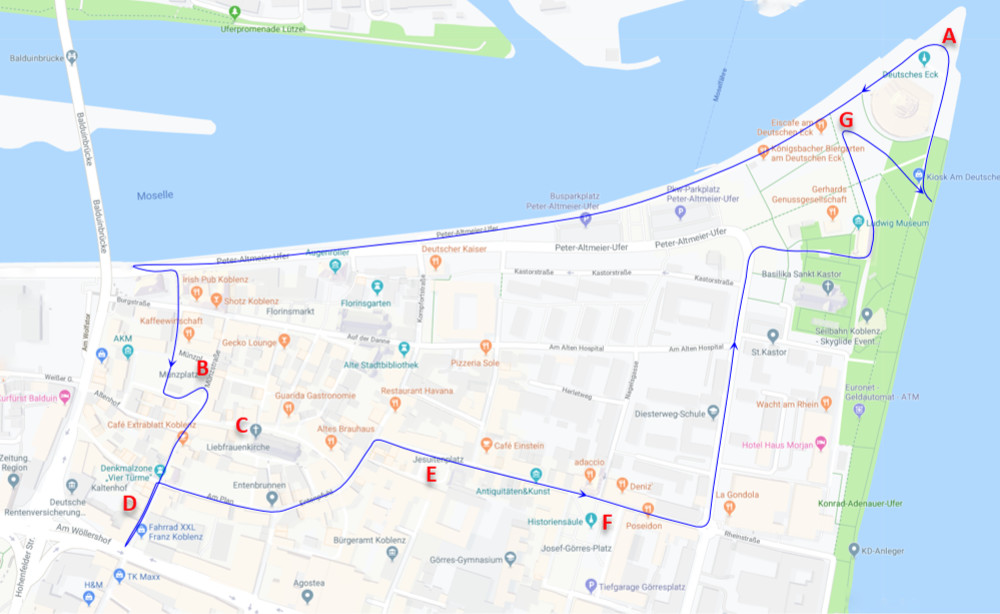
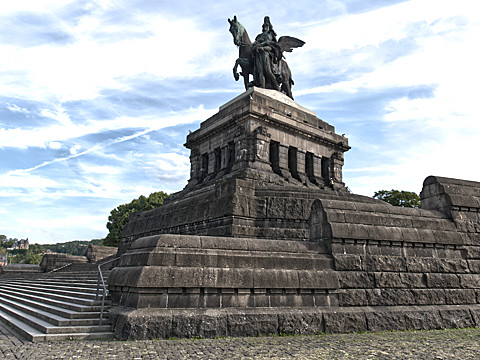
Our first stop was German Corner (A), at the intersection of the Rhine and Moselle Rivers, where flags of the 13 German states are flown and a giant statue of Emperor Wilhelm I presides - he united the German states into a country in the middle of the 19th century - over the meeting of the two rivers.
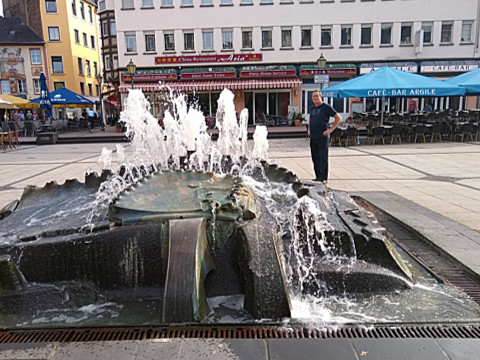
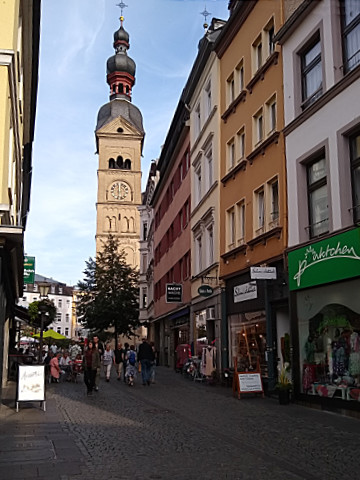
We walked the Peter-Altmeier-Ufer pedestrian walkway along the Moselle River dyke until we reached...
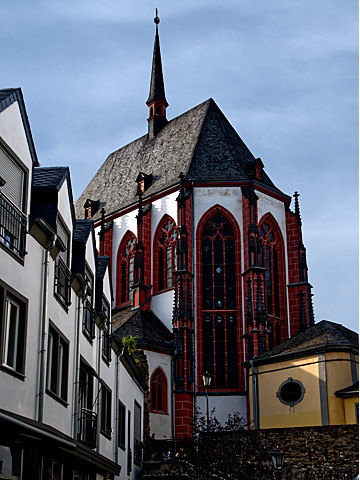
...the first bridge, then turned down a pedestrian walk to reach (B) Munzplatz (Munz Plaza) a fairly large city square that contained this fountain - of sorts. Of course Patty had to take Craig's picture.
As we started down Marktstrasse (Market Street) - the yellow building in the picture above is on this street - we looked to the left at the first intersection and saw (C) the Liebfrauenkirche (Liebfrauen Church). The next picture is also of this church, but it is taken from another street and shows the back. We were struck by the totally different coloring and design on the towers - there are two - and the church itself.
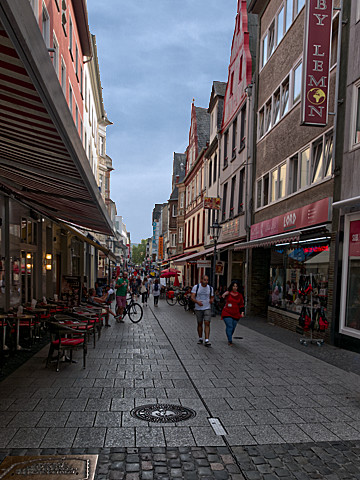
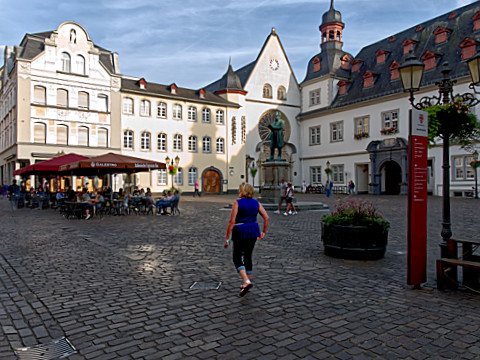
The Marktstrasse is a main shopping area (D), so we stopped to browse and took this picture. Then we walked to Firmungstrasse and caught Patty crossing the Jesuitenplatz (E).
Further along (F) we saw the History Column in Josef Gorres Platz
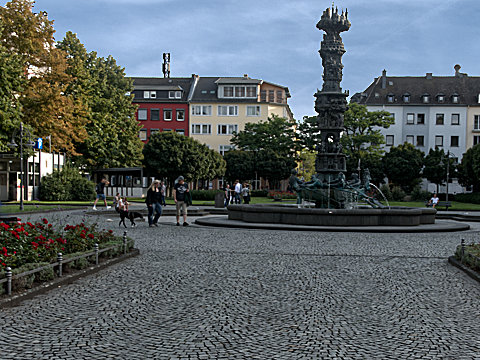
By this time we have pretty much lost count of all the squares in this city.
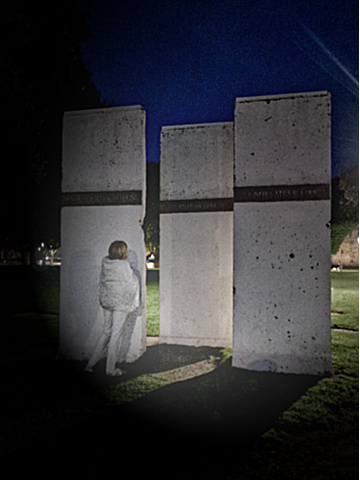
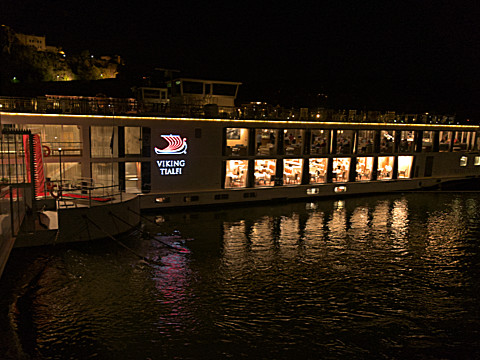
Meandering, we went back near the Wilhelm I statue and found three slabs that were taken from the Berlin Wall and formed a monument (G).
The Berlin Wall coming down is Europe's 9/11 - meaning European dates are day/month, not month/day and the wall came down 9 Nov 1989 (11th month).
We returned to Tialfi and took a picture of Patty in the 3rd floor library. Then Craig went up top for a last picture in Koblenz - of the Willhelm statue - just before we went to bed.
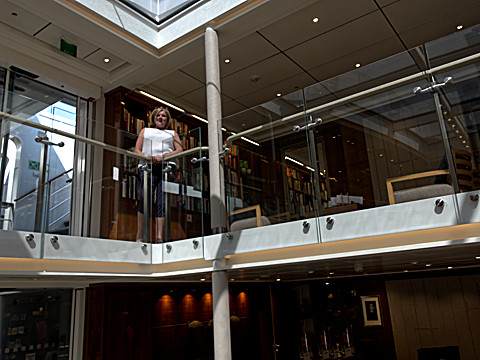
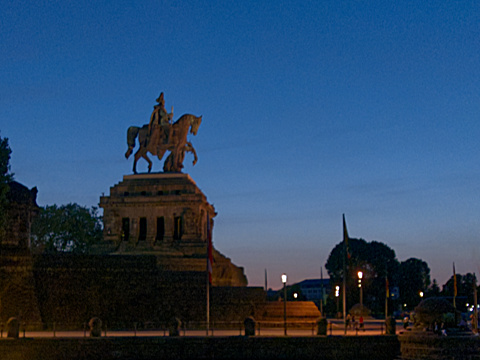
Cologne & Bonn, Germany
We arrived in Cologne around 9am and immediately took the Cologne Walking Tour, which mainly covered the Cologne Cathedral and surrounding area close to the river.
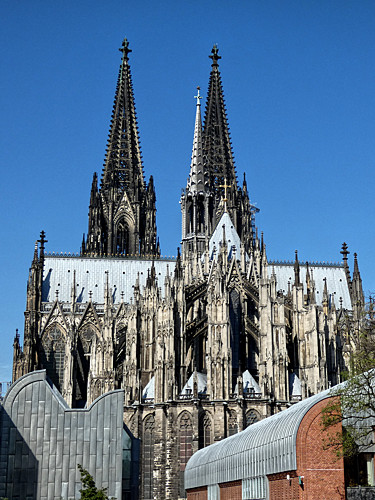
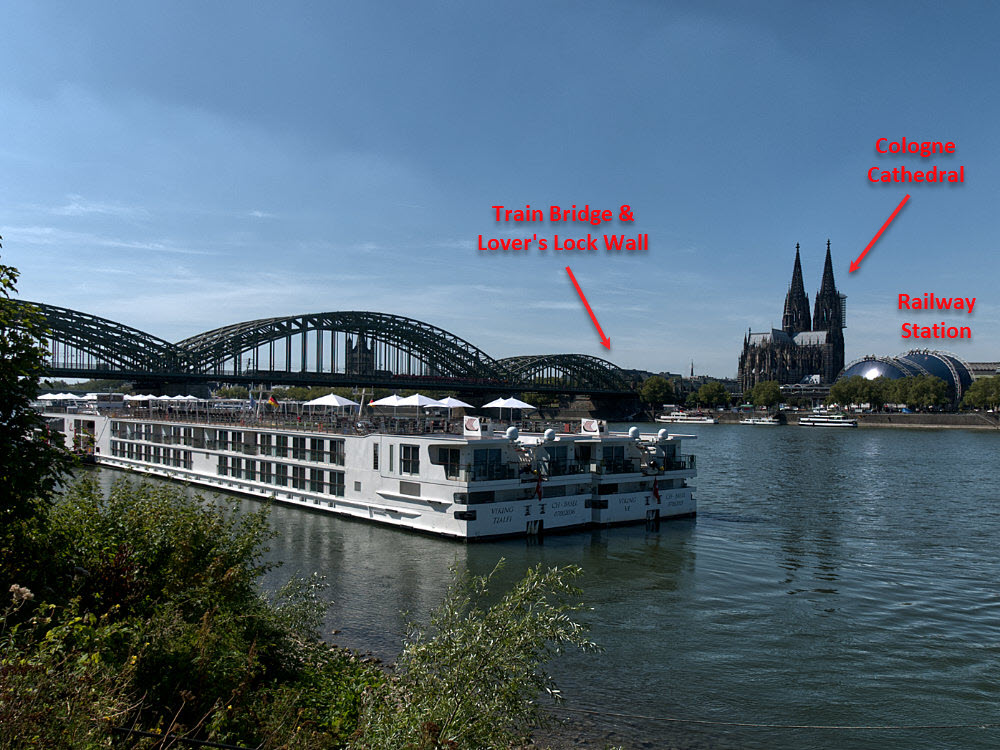
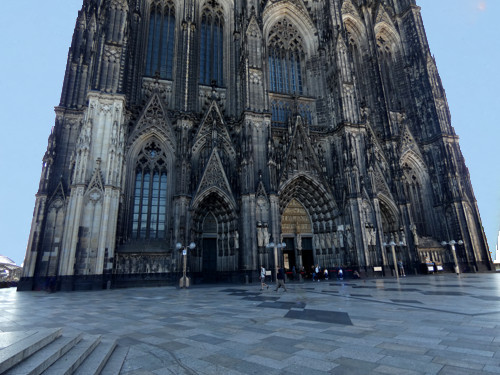
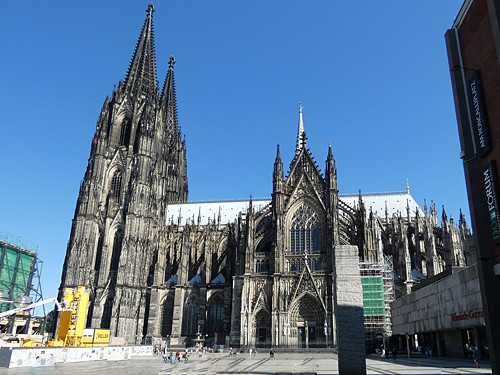
Our first view of the Cathedral is from the back side, then we see the massive entrance that is so big we couldn't get the camera to take it all in. Finally, there is a side view.
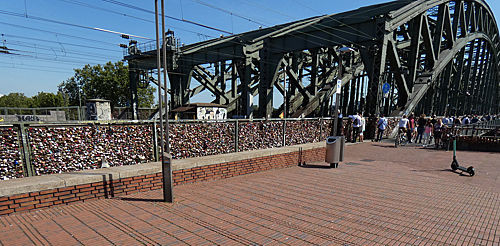
From the Cathedral area we walked back across the bridge to reach our boat. This bridge is the "Love Lock" wall where people declare their everlasting love by attaching a lock and tossing the key over the side of the bridge. The bridge is now so overloaded with locks that it is affecting the safety load factor and the city is considering simply cutting off all the locks.
Returning to the boat, we ate lunch and were picked up by a German friend (Phil) who was going to take us to Bonn and meet-up with Patty’s brother Gary, who has lived in Bonn for most of the past 20 years.
Bonn, Germany
It was a half hour drive to Bonn from Cologne, then we parked and made our way to Beethoven Square to meet Patty's younger brother Gary. As we walked to a nearby resturant for lunch, Patty couldn't resist this picture of flowers in the Beethoven Square.
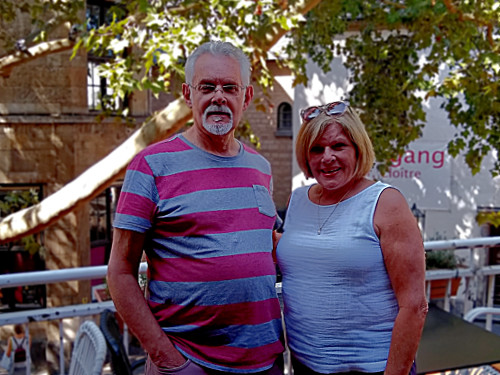
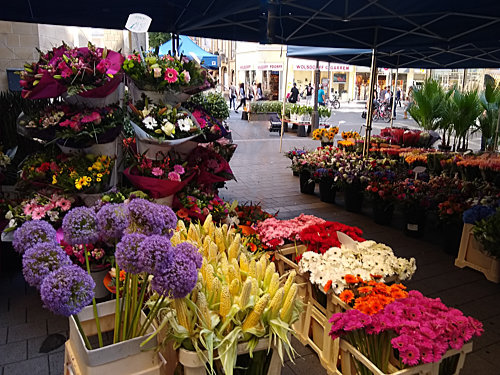
After lunch we set off to see the Drachenfels Castle ruins. Rather than walk up the mountain, we decided to take a cog railway to reach it . The view from the top was spectactular. You are looking up the Rhine, toward the castles we had passed the previous day.
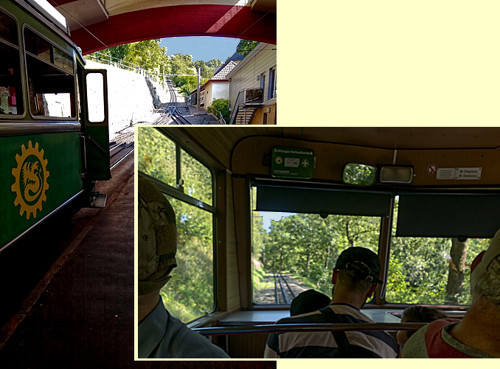
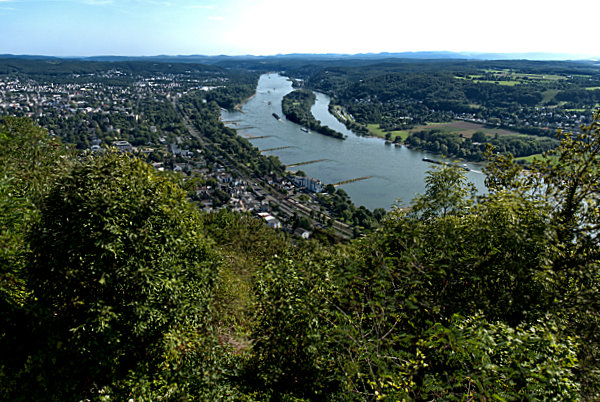
Turning around you can look up and see the ruins of the Drachenfels Castle Keep. As we started up the Keep trail, you can see Patty inspecting plaques on the walls.
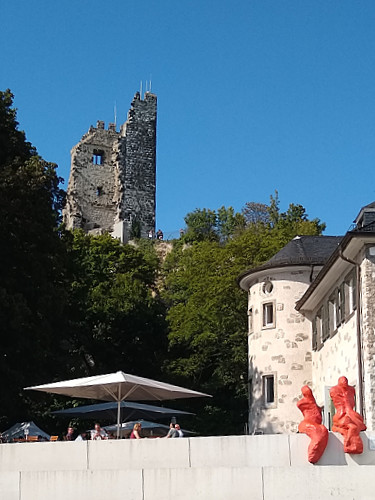
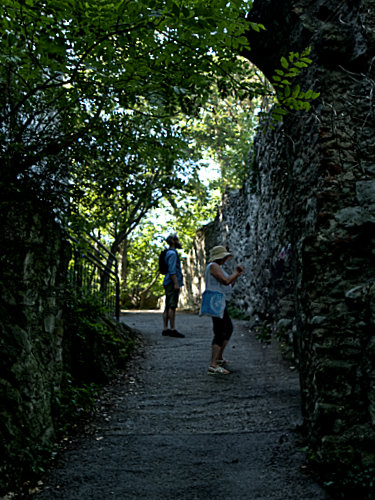
Here we see Gary, on his way. Finally we all reached the top and took this picture of Gary in front of the Keep.
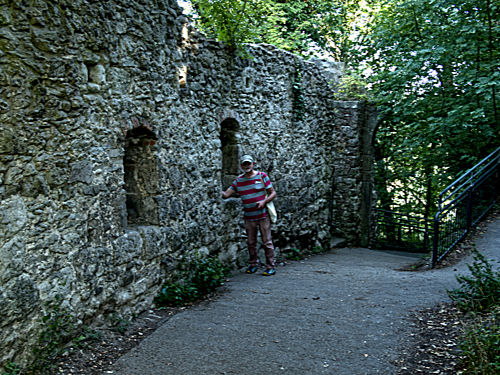
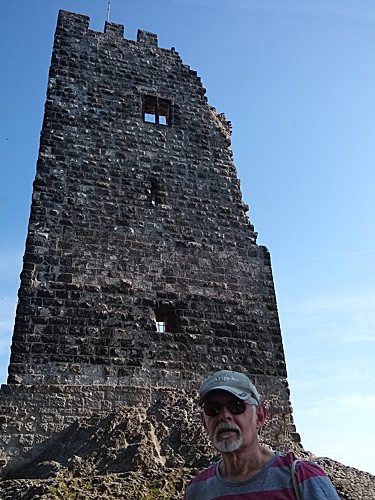
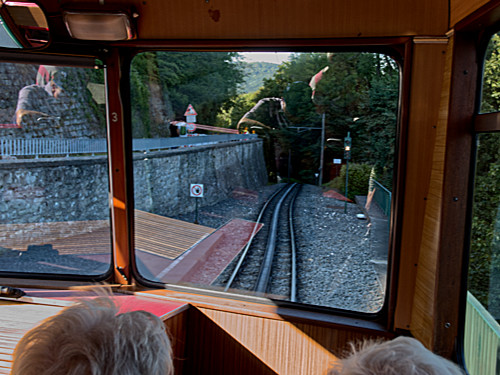
Climbing down from the Keep, we took this picture of the Cog Railway as it started down the mountain.
Back in Bonn, we stopped at Rheinaue Park and walked quite a ways in this extensive and lush area.
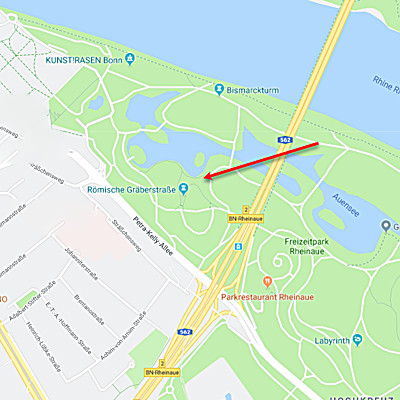
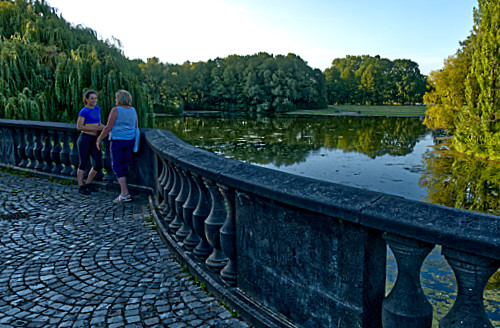
Here we see Carol (Phil's girlfriend) & Patty at an overlook area - identified by the arrow - just before we entered the Japanese Gardens.
We were a bit tiredof walking, but it was still a very restful stop in our travels.
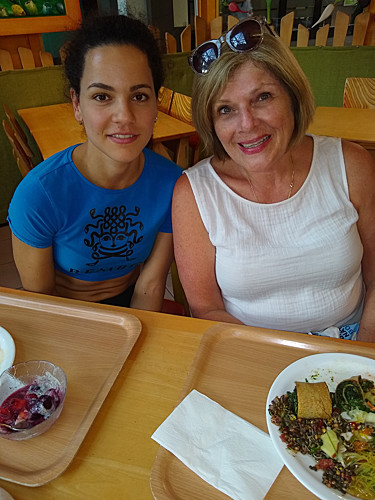
It was time to get dinner, if we were going to return to the ship by 9:30. It was leaving at 10:30.
This stop at a vegetarian cafeteria proved the perfect place for all of us - it was also the place the other three had met each other in earlier times.
Always tough to say goodbye, after such a short day, but the boat was going to cast off and we had no choice.
Here we see Cologne & the Tialfi in the background, with Craig, Patty & Gary. We have no idea when we will all meet again.
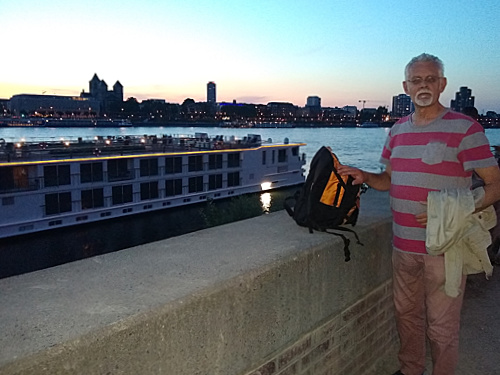
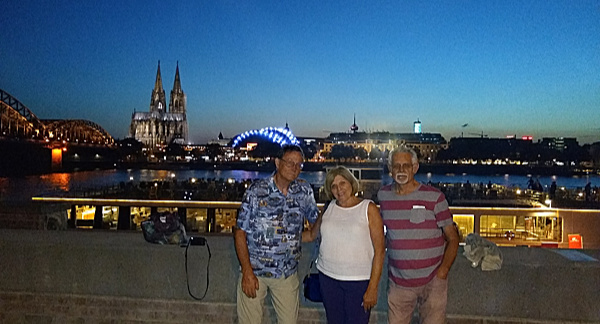
Kinderdijk, Netherlands
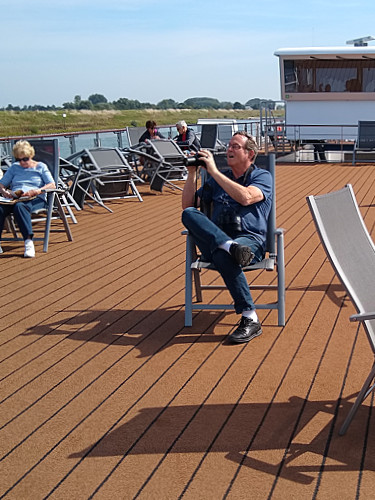
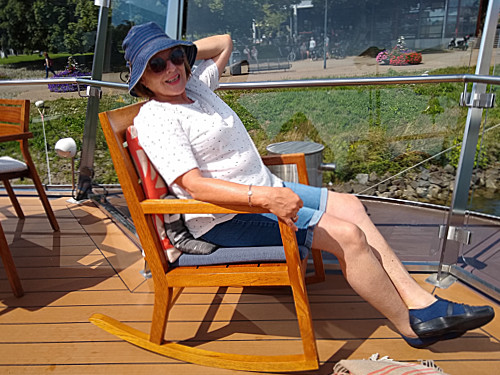
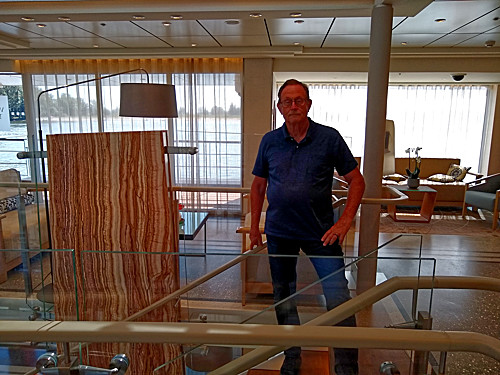
We were moving through the lowlands all night and the next day until 1pm, when we arrived at Kinderdijk, Netherlands.
Much time was spent on the 4th deck looking for something to photograph, or rocking on the 3rd deck forward - simply looking where we were going.
Strolling the ship, we see Craig leaving the Lounge and heading down the stairs to our room.
Kinderdijk, the city of windmills - most of the functioning windmills in the Netherlands are in the area surrounding Kinderdijk. Below we see the windmill we toured.
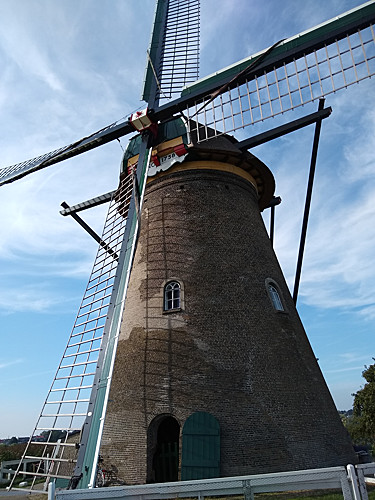
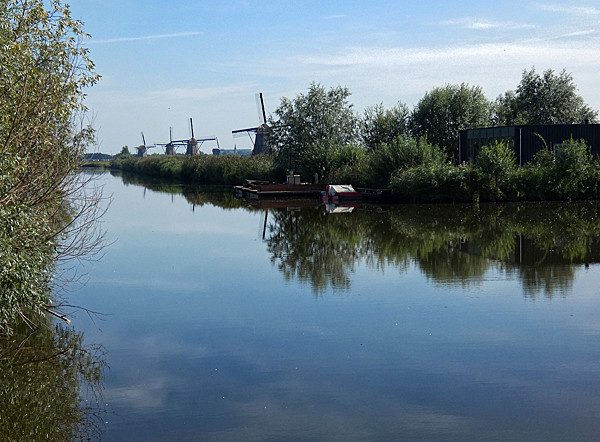
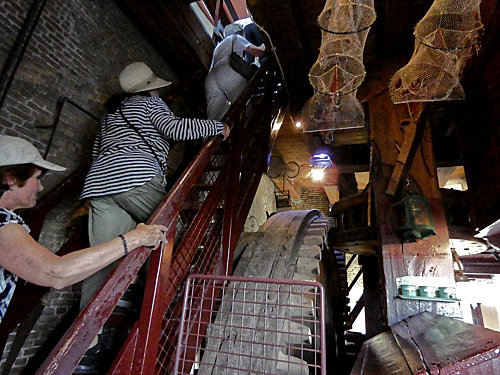
Living in a windmill is an exercise in space management. Here we see the first floor stairway.
A couple of stories up this was the view of the outside world.
The kitchen was small, but well organized.
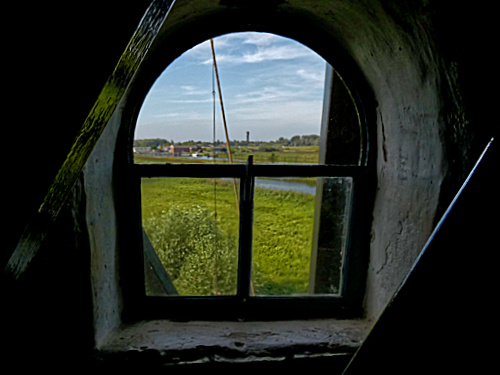
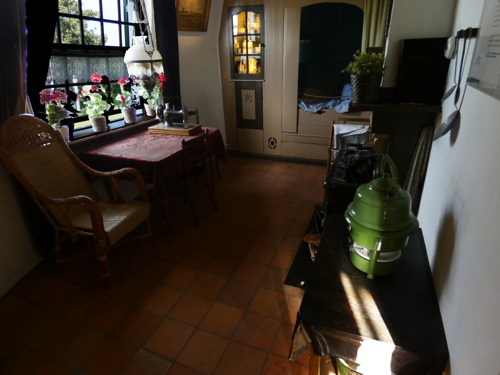
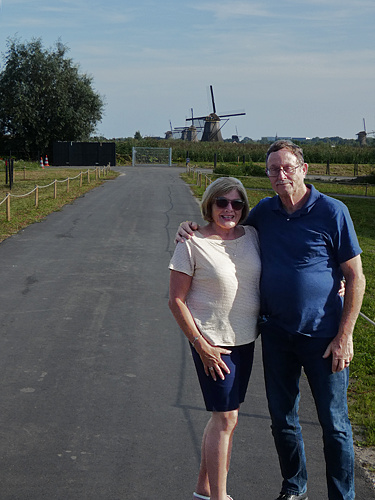
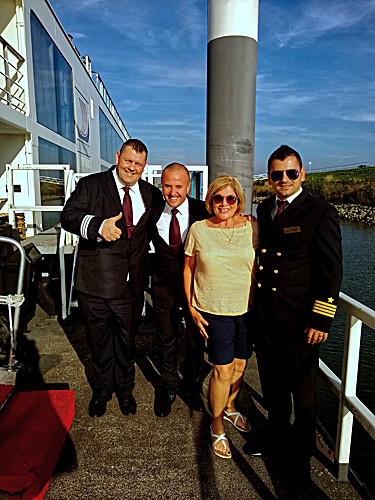
The Dutch are world experts at water management and we discovered the method of maintaining water levels is far more complex that we had previously thought. Various locks keep different areas at different water levels so that storms and tides cannot overwhelm any large area and there is always enough fresh water available to keep things growing properly.
Here we see Patty & Craig preparing to leave the area of the windmill.
Patty had this picture taken with the Captain when we reboarded. Of course the head of food & housekeeping and the Entertainment Director had to get into the act.
We had cast off before dinner was served and headed up the river to a canal linking Kinderdijk with Amsterdam - arriving & disembarking the following morning.
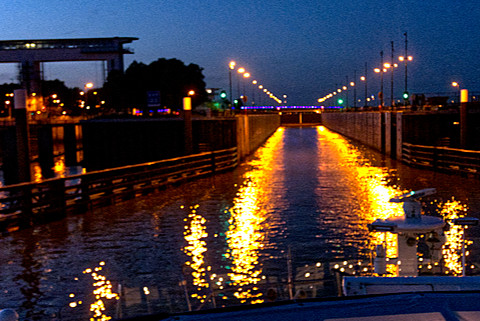
As darkness fell, we entered the last lock of our journey. This picture is different in that you can see just how long and narrow the locks are - this defines boat design along the Rhine River.
Amsterdam, Netherlands
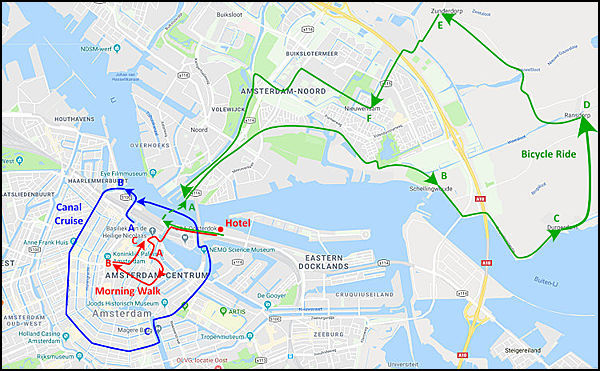
We were staying an extra two nights in Amsterdam, so our luggage was not only delivered to our hotel, but to our room. We were bussed to the hotel and immediately set off on an included walking tour - shown in red on the map.
The city tram system was just as efficient as in Switzerland, but it wasn’t free, however, the ferries were.
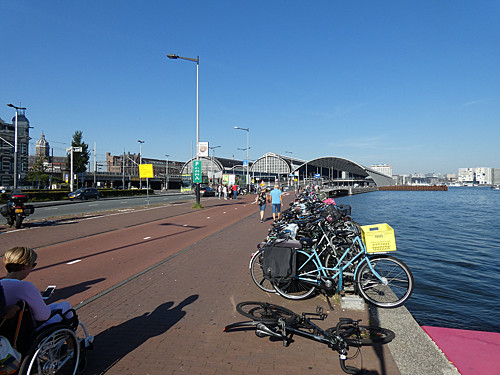
There were bicycles all over Europe, but in Amsterdam it was the predominant mode of transportation and there were parking garages just for bicycles. Most people had a bike for work/casual use and one for when they wanted to get out and simply ride.
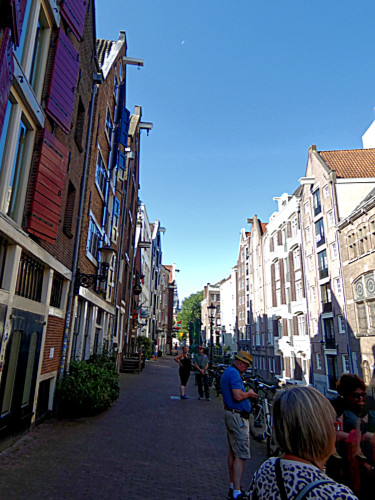
The map shows our Walking Tour, our evening Canal Cruise, plus our second day Bicycle Ride.
Our tour took us through most of Old Town Amsterdam - the Venice of northern Europe. The canals in the newer part of town radiated out in a semicircle around Old Town and our Canal Cruise showed us this. We walked first through the Central Station, a business section, the red light district, a large square with a farmers market, and concluded at the Palace.
Sidewalks and streets are build along most river/canal banks, rather than people’s houses, thus allowing all citizens access to these natural gathering places.
Walking down the streets we again saw all the shops/homes canted forward, with a hook at the peak of the roof (A). This was so that heavy objects/furniture could be moved into the upper floors - the canting because that gave the objects room to swing a bit while being lifted.
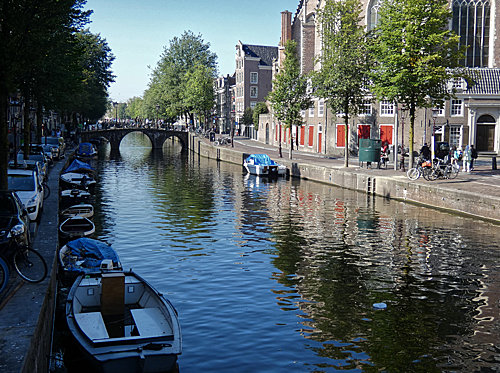
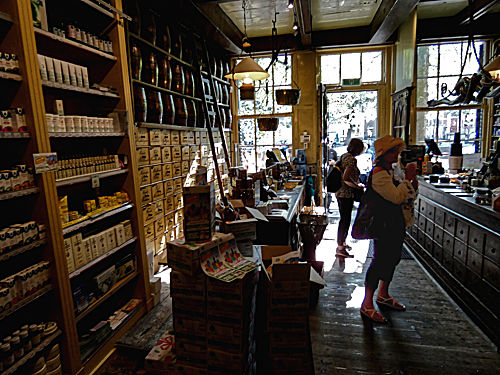
The Red Light District is along the canal shown above and looks like any other part of the city in the daytime. The buildings are all well kept and there is nothing 'seedy' about it.
We came upon an old hardware store - opened originally in the 17th century. The owner has many storage items that go back to that time. It was like walking into a store on Disneyland Main Street, but much older.
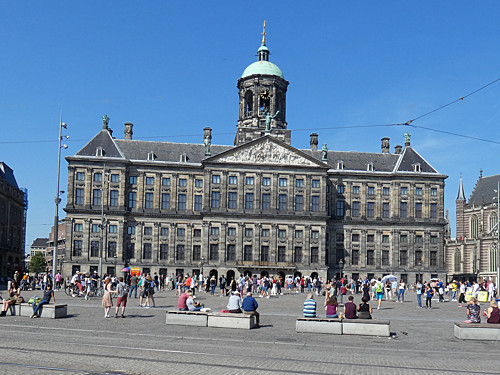
The formal walking tour ended at the Palace (B) - the King and Queen don’t live there, but do come in for functions and meetings.
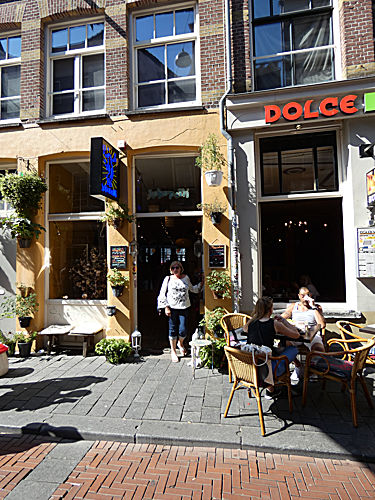
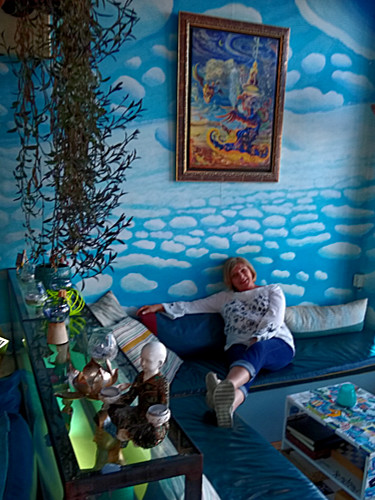
We walked back via Warmoesstraat, the area where all kinds of legal drugs were available.
Stopping at the Burger Bar for lunch, we found all sorts of good food available that didn’t include meat. Here we see Patty exiting after a filling lunch.
Our next stop (C) was almost across the street. Kokopelli, a full service shop for drugs - recommended by Patty's brother Gary - and spent a while looking around. We did get some of their Magic Mushrooms, but didn't take advantage of this room for their customers to get high - even though Patty relaxed here for half-an-hour or so.
We went back to the hotel and made a reservation for a canal tour in the early evening - to see the outer canal part of Amsterdam.
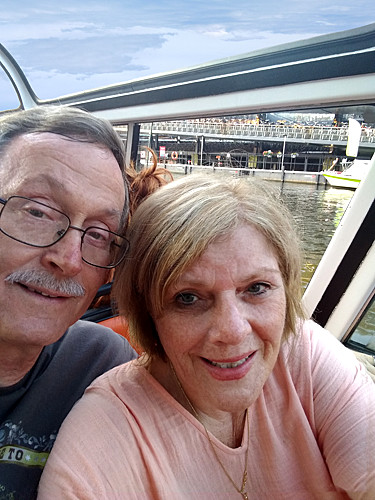
The pickup point was near Central Station (A), so out we went.
Below is what the boat looked like as we boarded it.
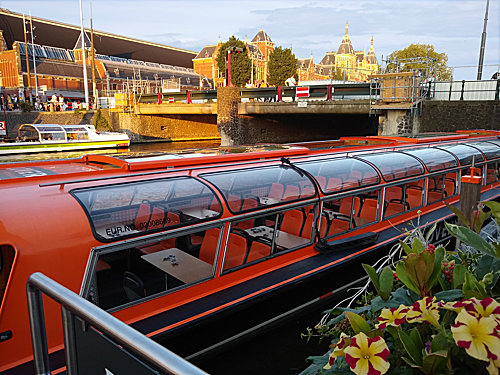
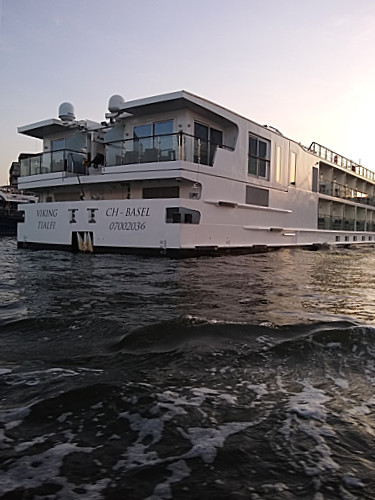
The one hour tour took us by the Tialfi (B), as it was preparing to leave again that night, and to the Prinsengracht Western Canal.
Following this canal around to Amstel River Canal we jogged up to Nieuwe Hereengracht (C) and out into the harbor, before returning to our start point.
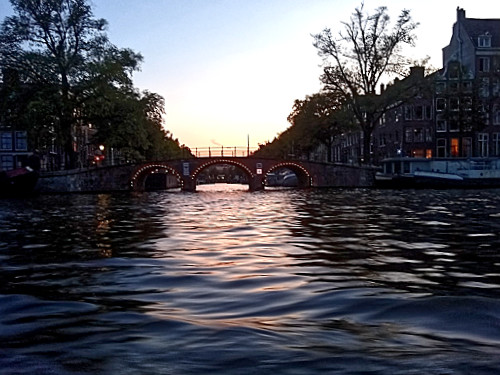
In addition to the cars and bicycles along the canals, there are houseboats that are permanent residences - the number is limited to what currently exist - so the canals can get fairly narrow in places.
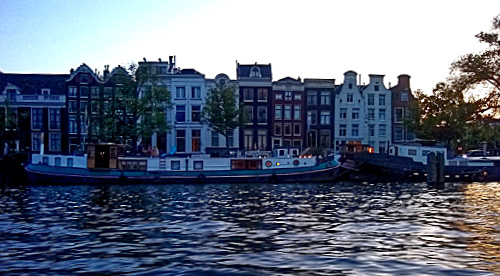
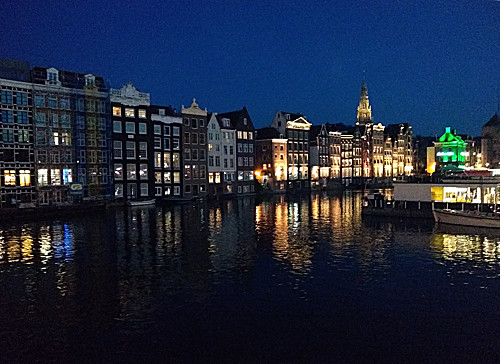
We wandered a bit going back to our hotel room and got this memorable shot of Amsterdam at night. Building colors in Europe are so much more varied than in the U.S. and these two pictures tell that story. Culture and a limited number of homeowner associations do make a difference.
This had been a full day of sightseeing and we didn't really want to walk back over some of the same streets we had covered multiple times during the day, so...
Day Two
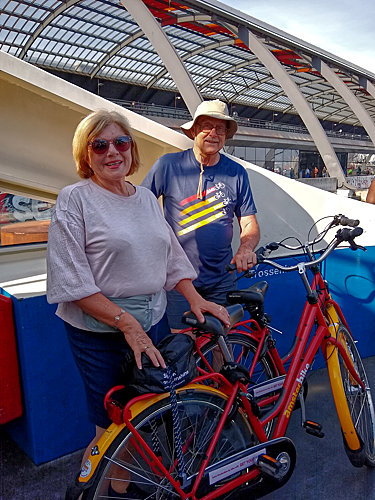
...Sunday, our last day in Amsterdam, we decided to rent bicycles and see some new areas. We were advised to avoid the city, so we rode over to a ferry and crossed to the north side of the harbor and started out on the streets and bicycle paths.
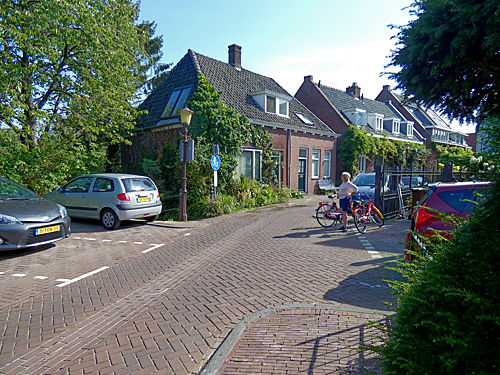
We had been given five small towns we might see and we managed to see them all. A nice lady advised us to take a particular street to the end to reach our first town (Schellingwoude) and we followed the road until it turned into a bike bath on the dyke next to the harbor.
This we took into town and found there were more bike paths available than roadways, and they were all paved and marked for bicycles. When we crossed the outer ring highway (A10) we found we were no longer in Amsterdam and everything was far more rural. The next town was Durgerdam and it had only one main street, but we found three Teslas parked in front of residences there - the Europeans do like their electric cars.
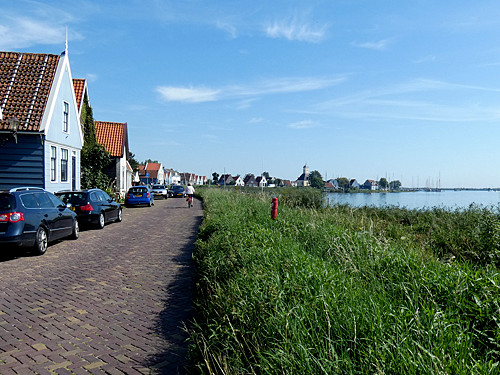
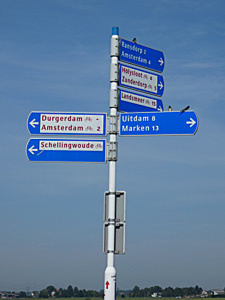
Next was Ransdorp and we made our way mostly by bike path, hardly touching the road until we entered this quaint, little town.
There was a couple sitting near this little church and they directed us to the best bike path to take to the next town - Zunderdorp.
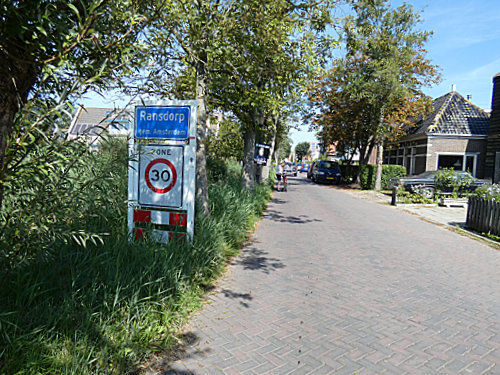
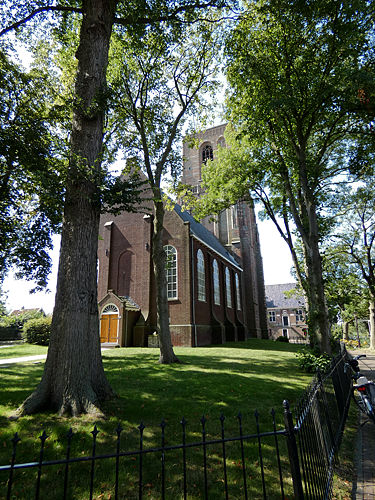
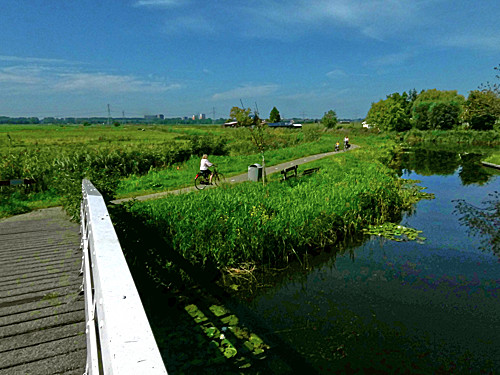
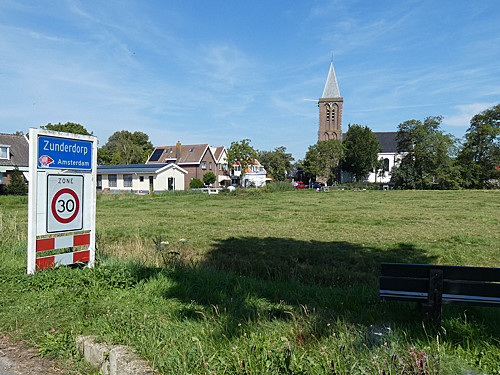
As you can see, the bike trail was well maintained and it was really idealic to ride through the farms - away from any traffic. We joined the highway just before arrival.
On our way to the fifth town we took a picture of this stork. We had been hearing stories about storks for the entire trip. It seems this bird is really the good luck symbol of Europe and they always come back to the same nest - they had started migrating south and we hadn't seen any until our bike ride.
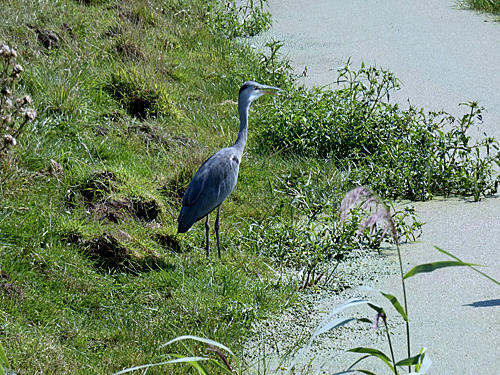
Nieuwendam was back inside the A10 loop and thus a part of Amsterdam. We discovered this strange home design we hadn't seen anywhere else in the world. Here the homes were built straddling the roads. What you see are not garages, but the highway lanes passing directly beneath the houses. This wasn't true everywhere, but just along the town's main street.
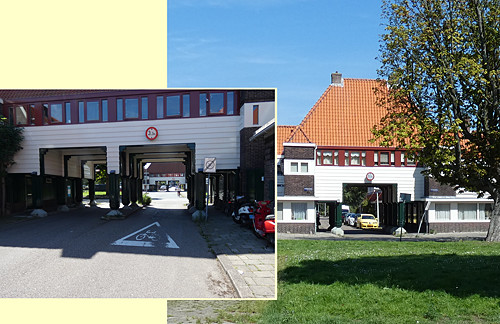
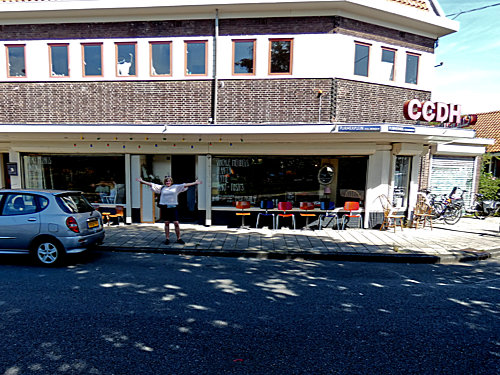
Finding a local coffee shop, we stopped for tea and a bit of rest. Patty was feeling exuberant and we got this picture of her in front of the coffee shop.
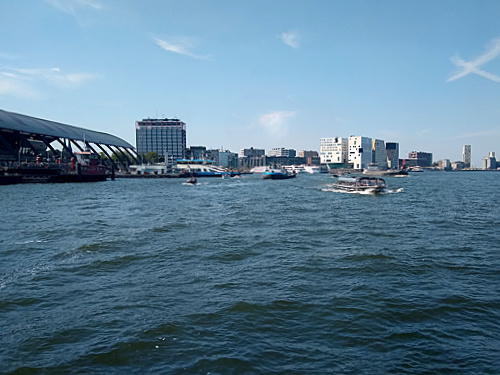
We made it back to the ferry and returned the bikes to the rental shop next to the hotel - we had traveled 23 km, or almost 14 miles. It was a very unique day and we were both glad we had taken a chance on the ride.
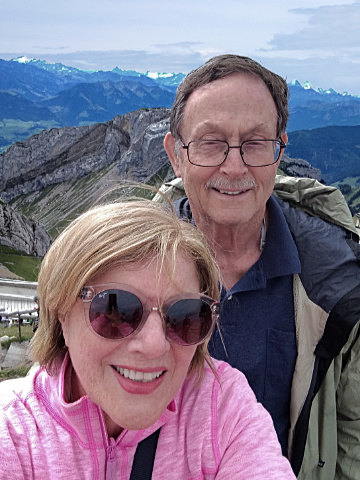
Early the next morning we had to leave for the airport and our long flight home. There was time for shopping before our flight - we agreed to use up our remaining Euros and not to pay an exchange fee that would exceed our remaining cash. This was a very different vacation and our memories will be good.
We leave you with this selfie of us in the Alps.
All these pictures are for us, but we hope you enjoyed them

